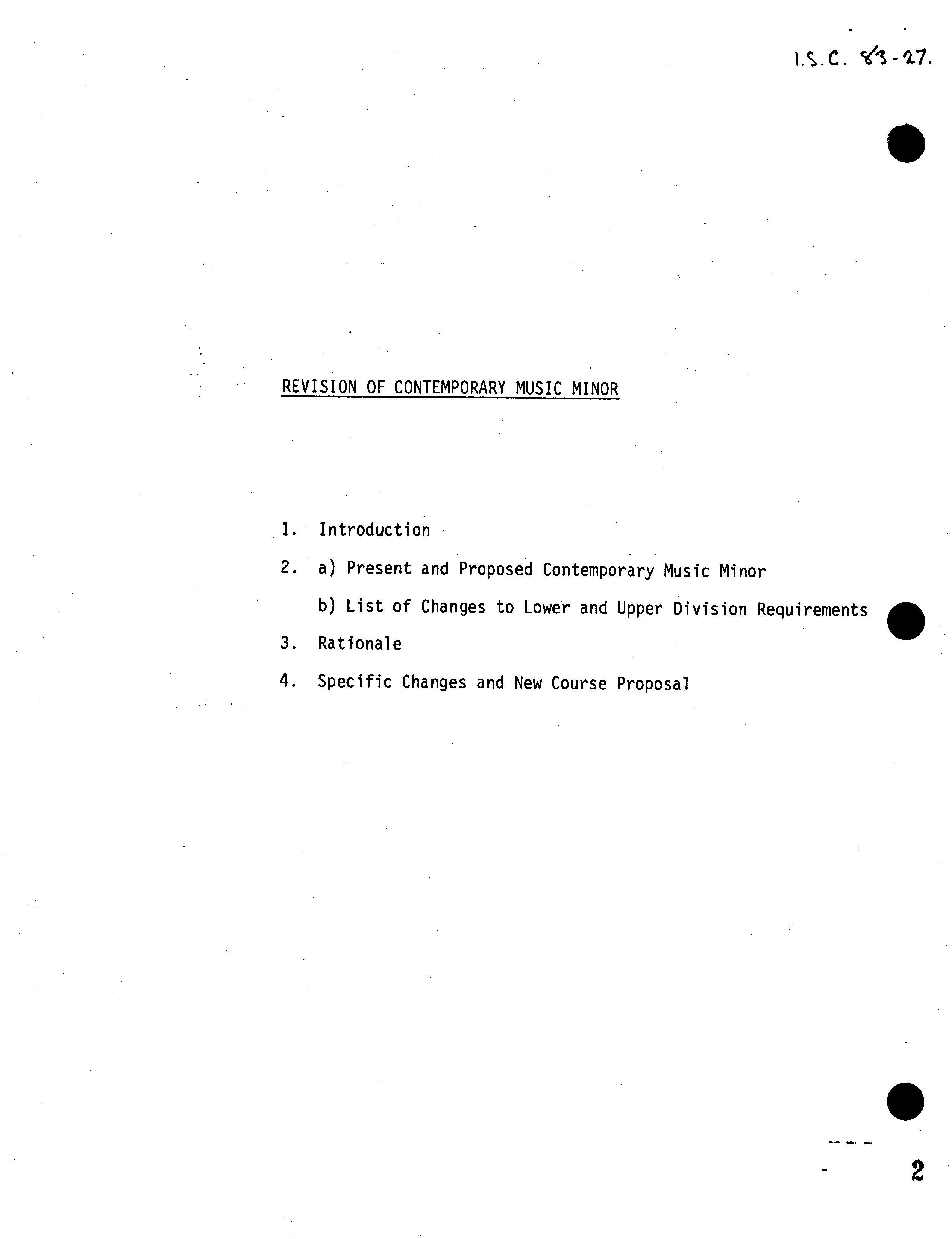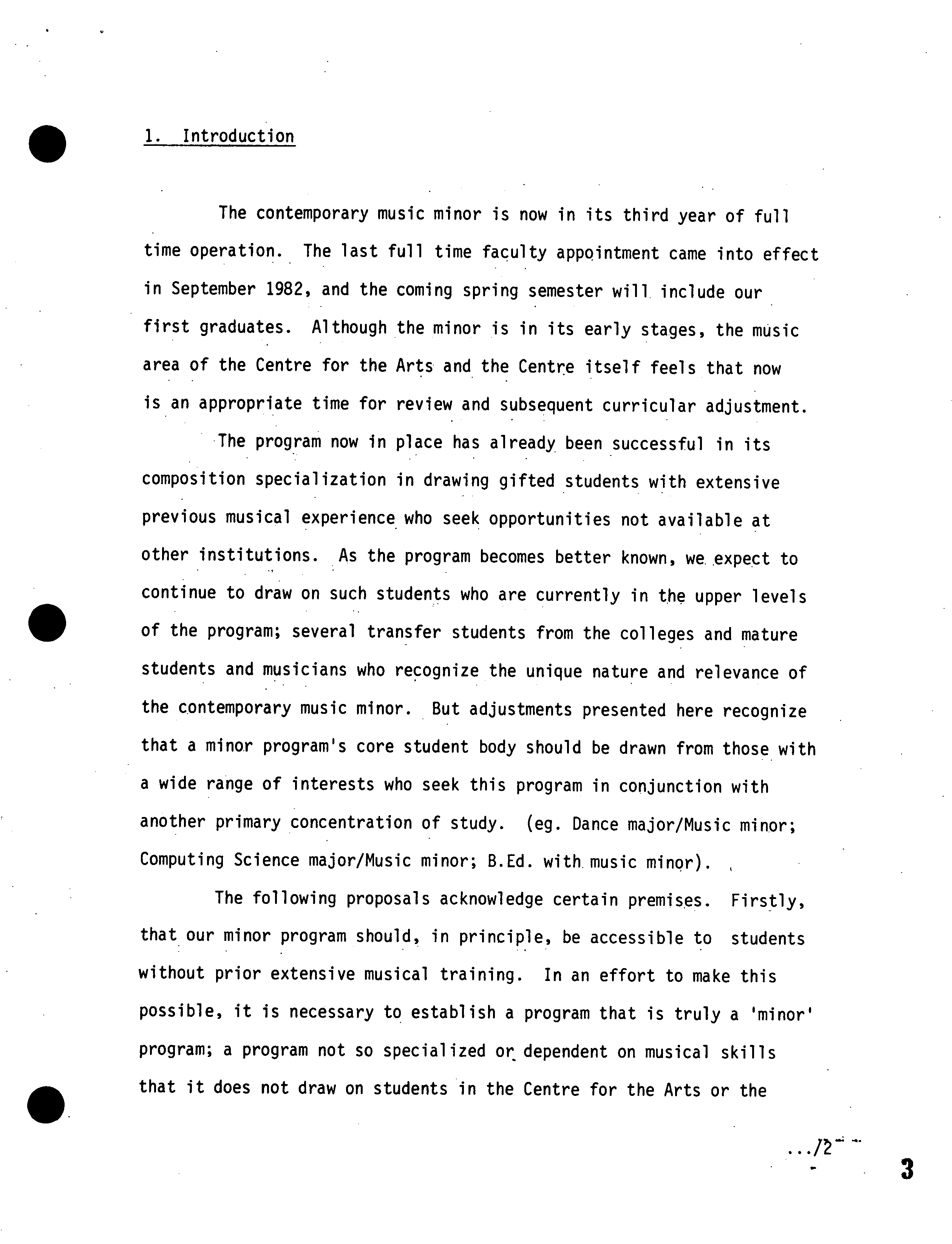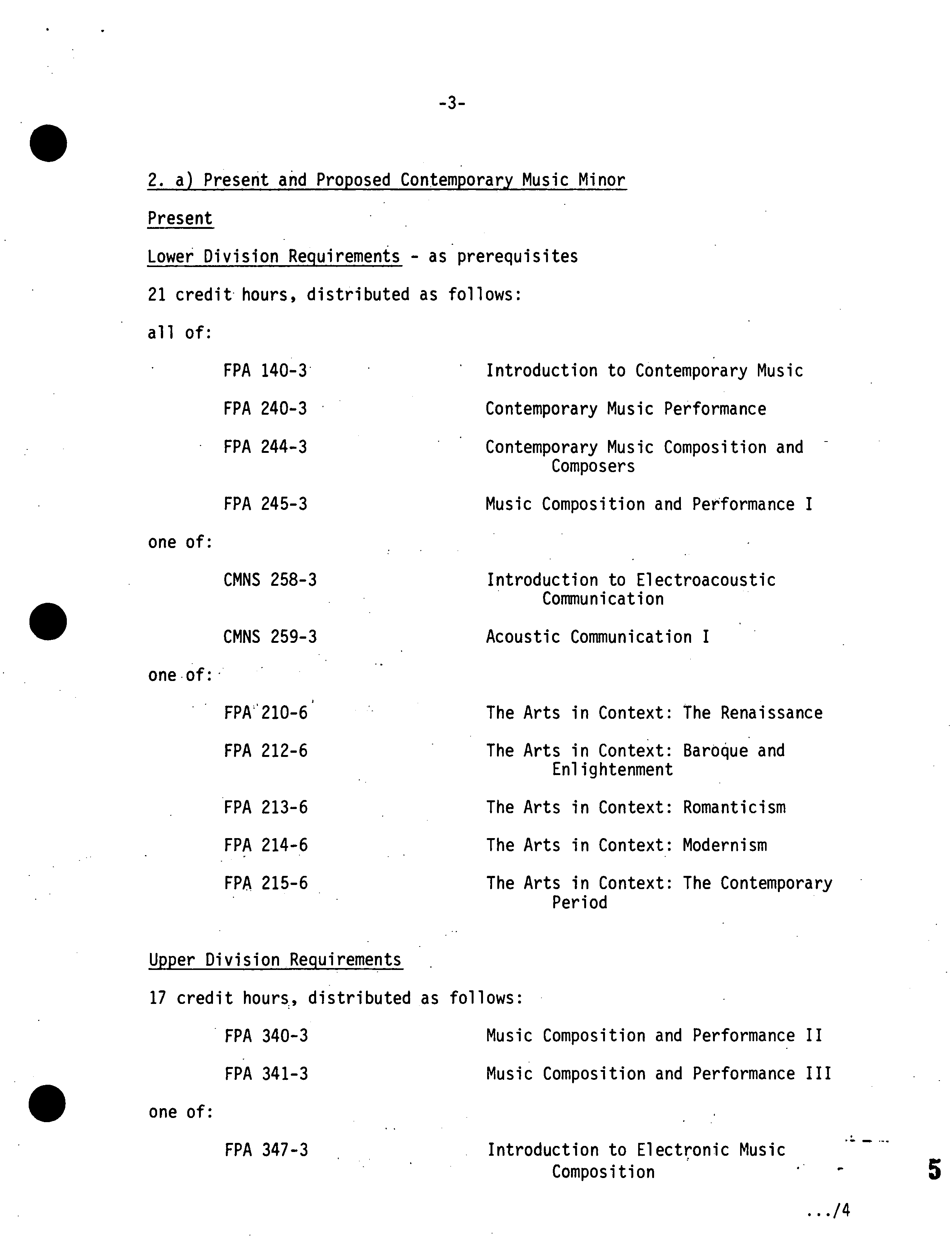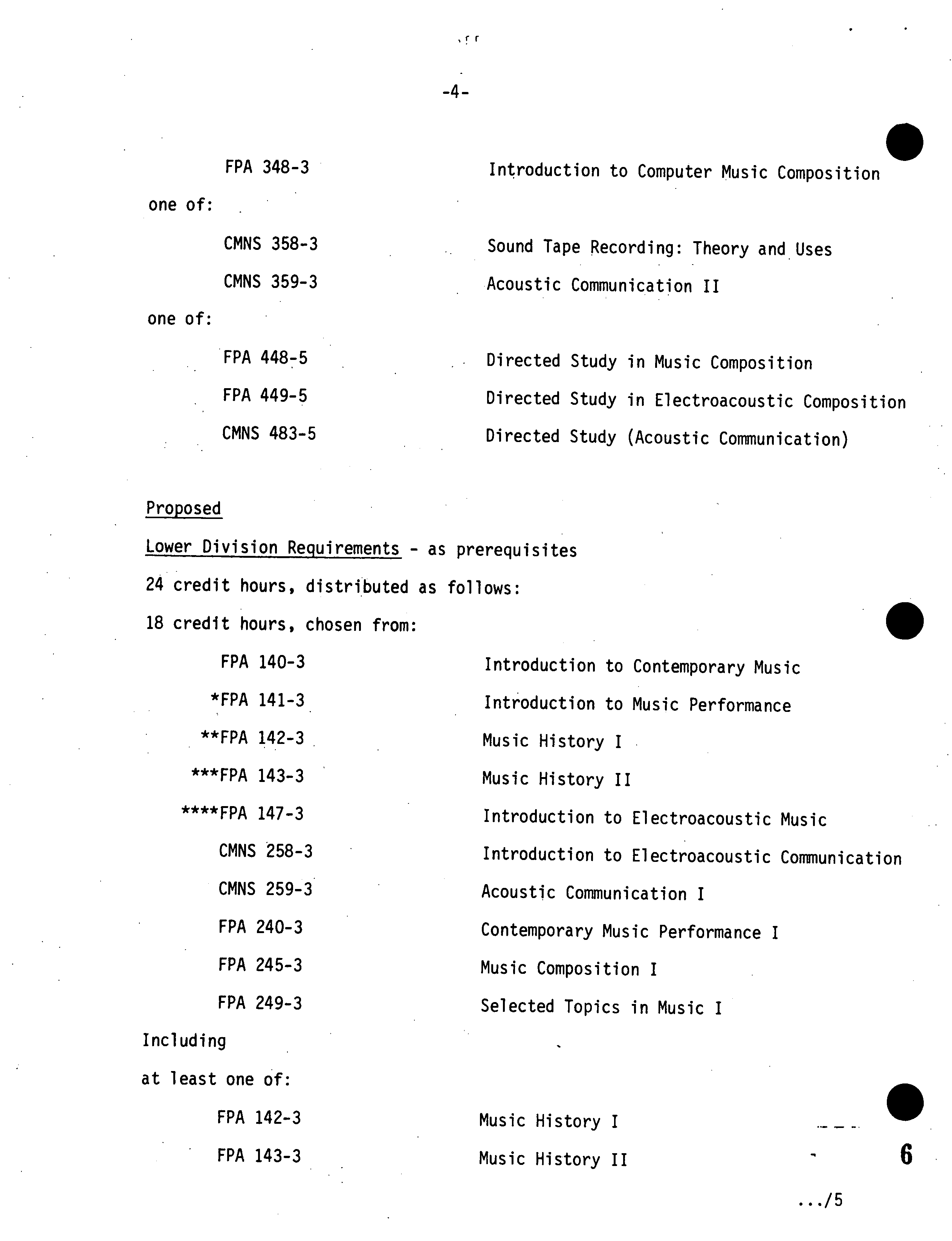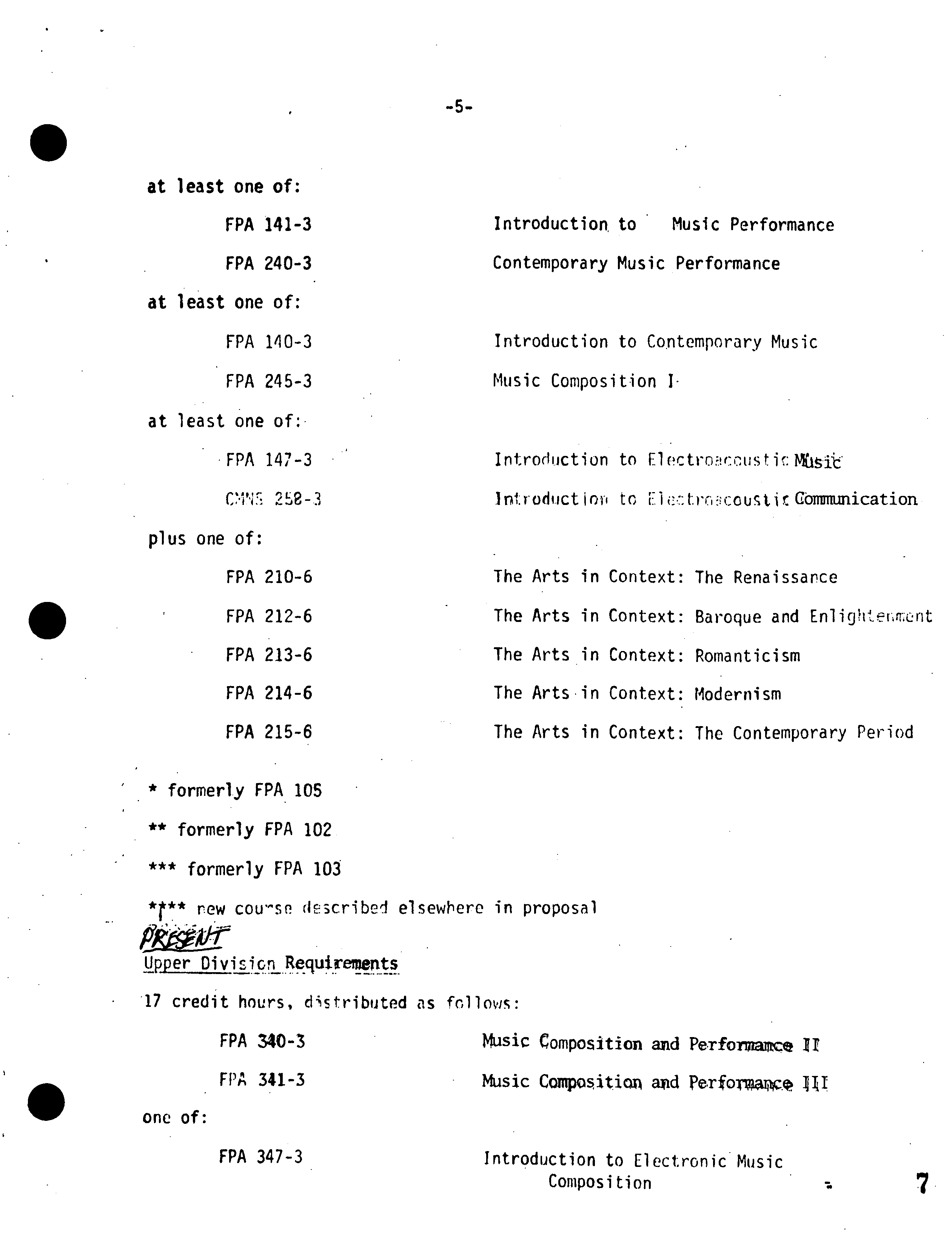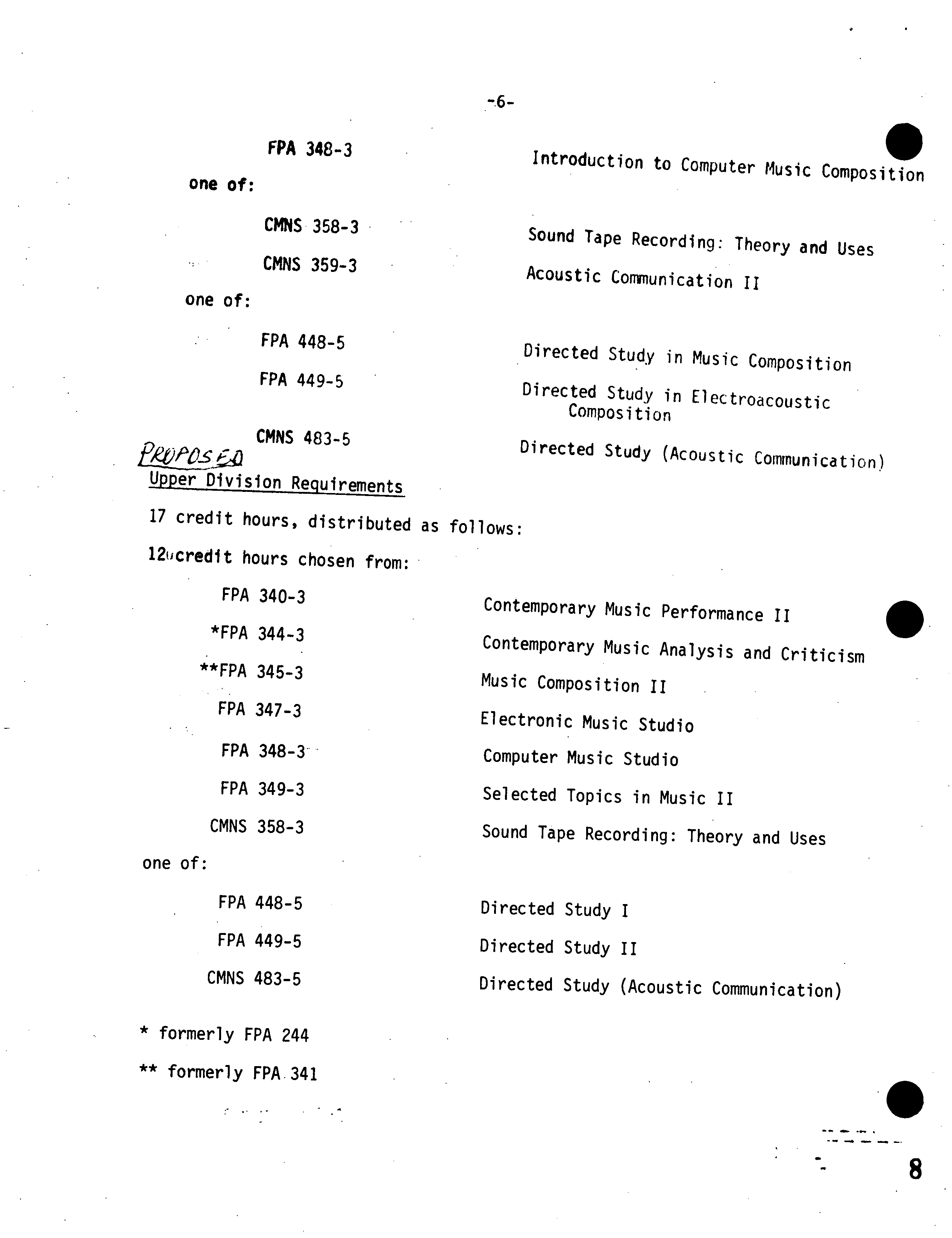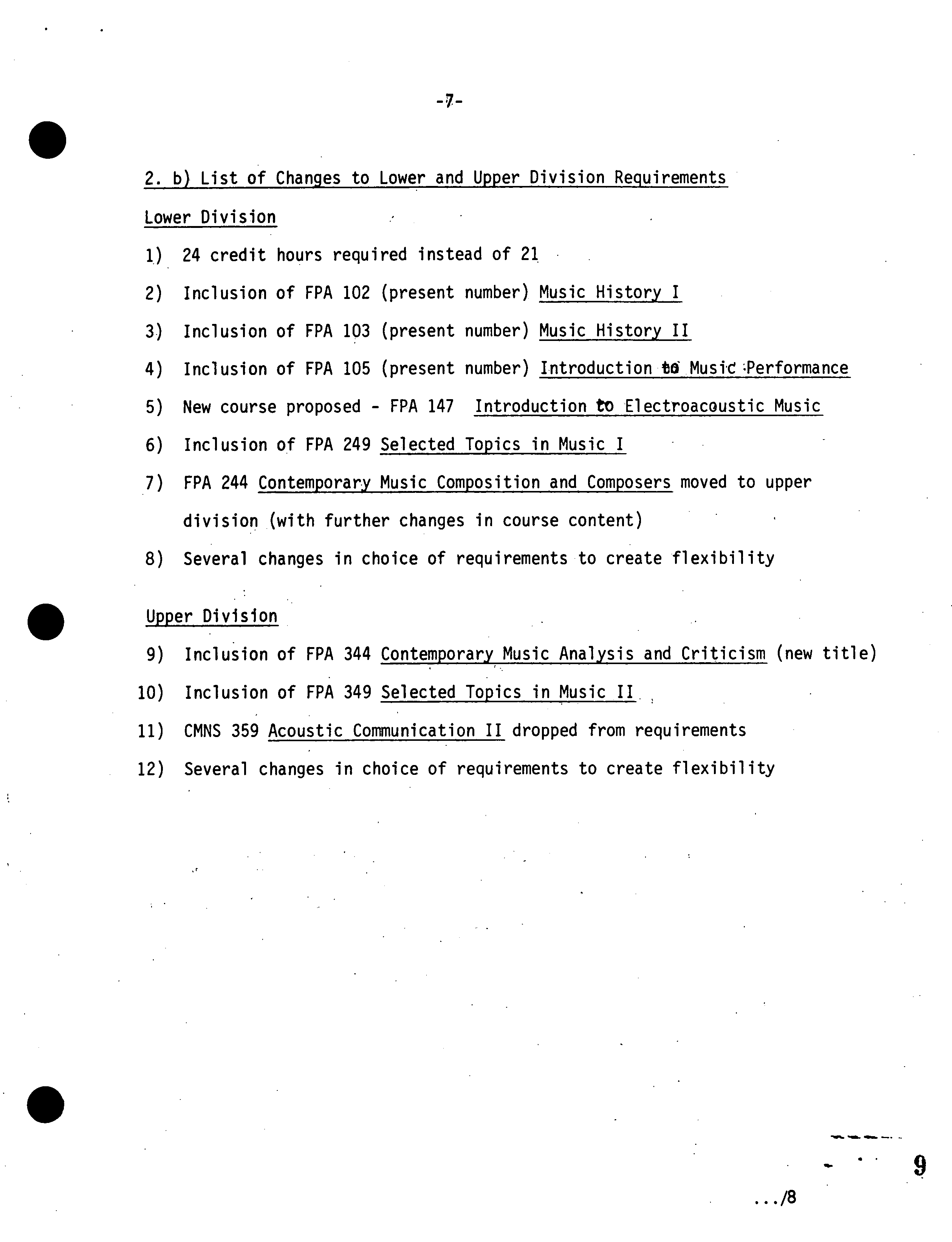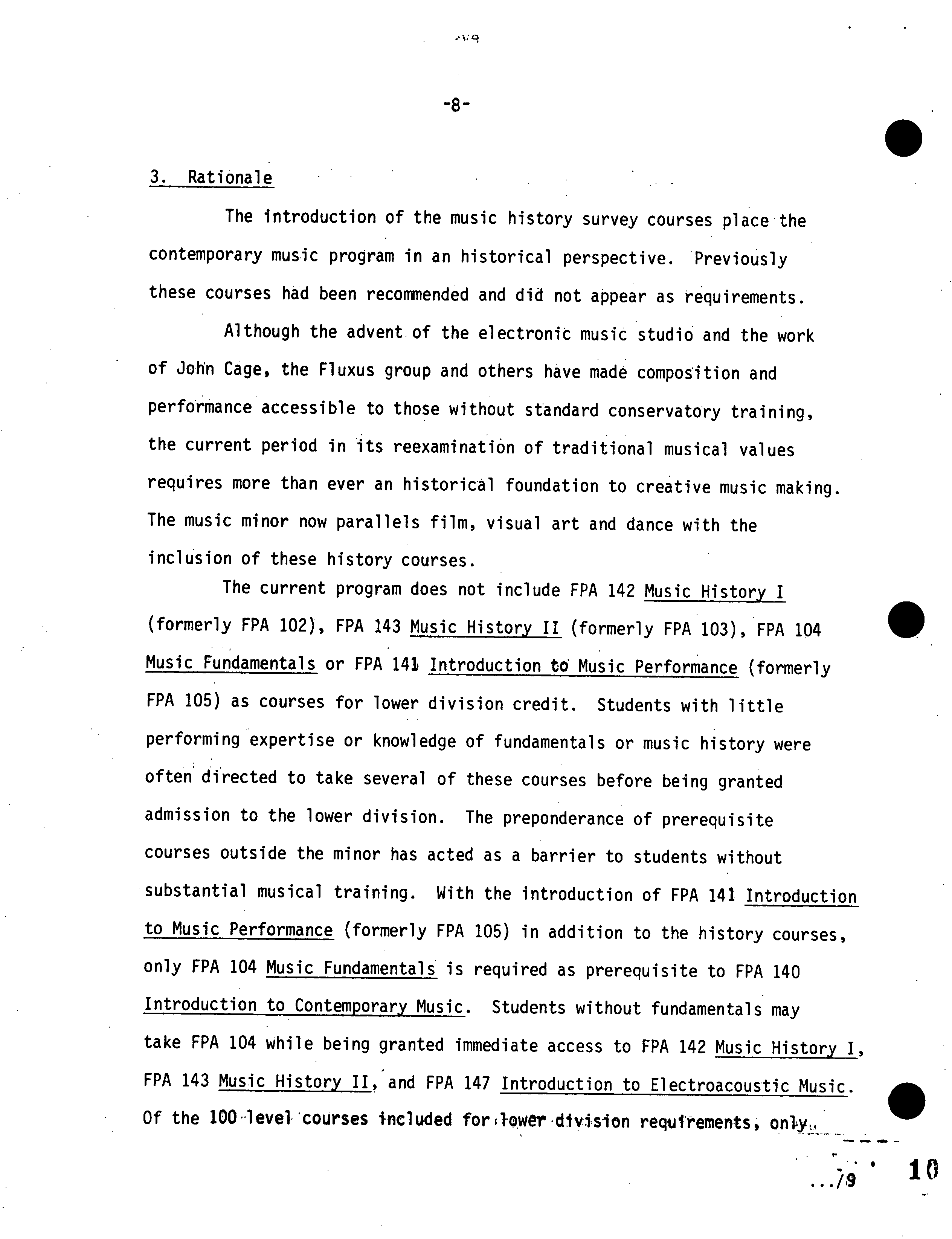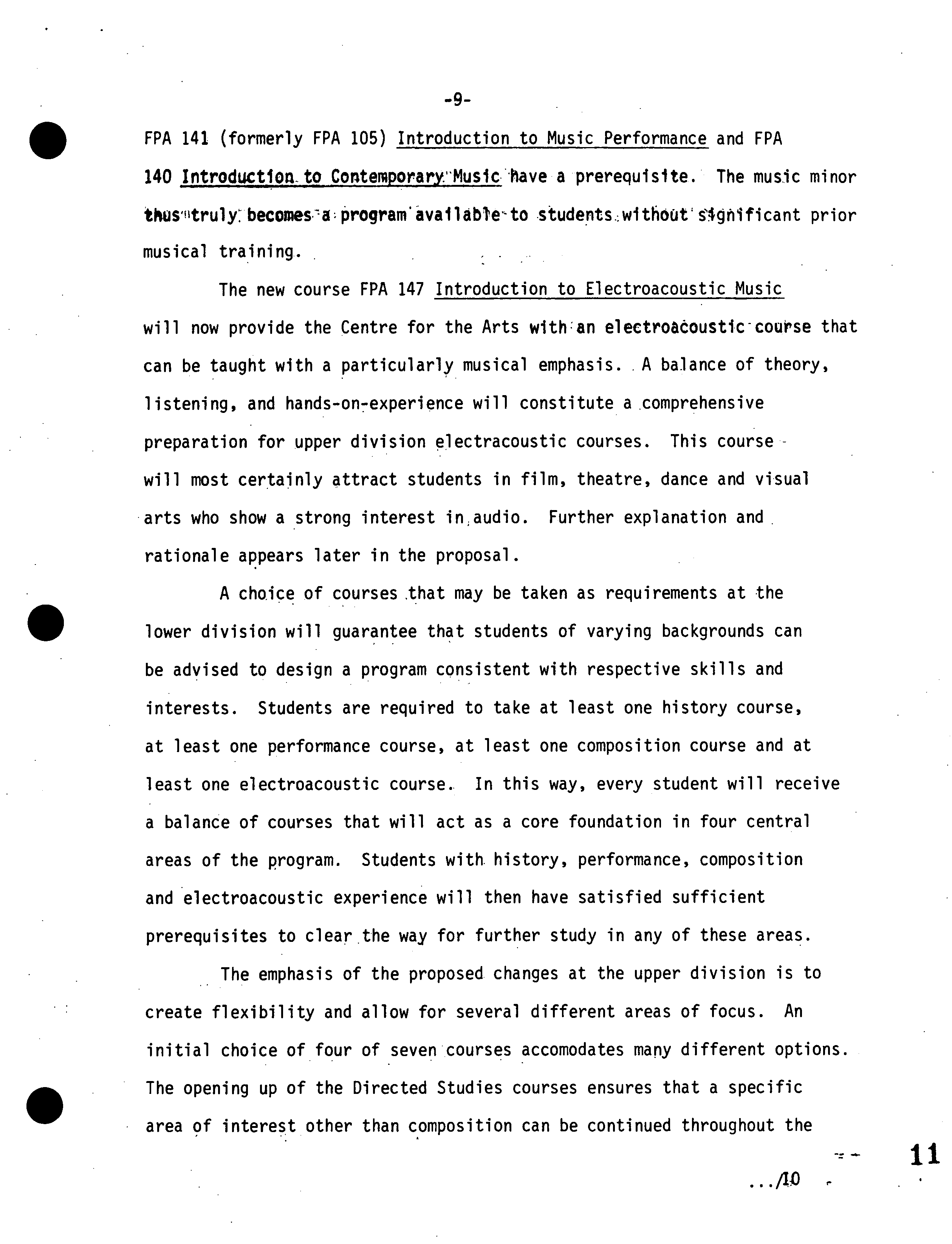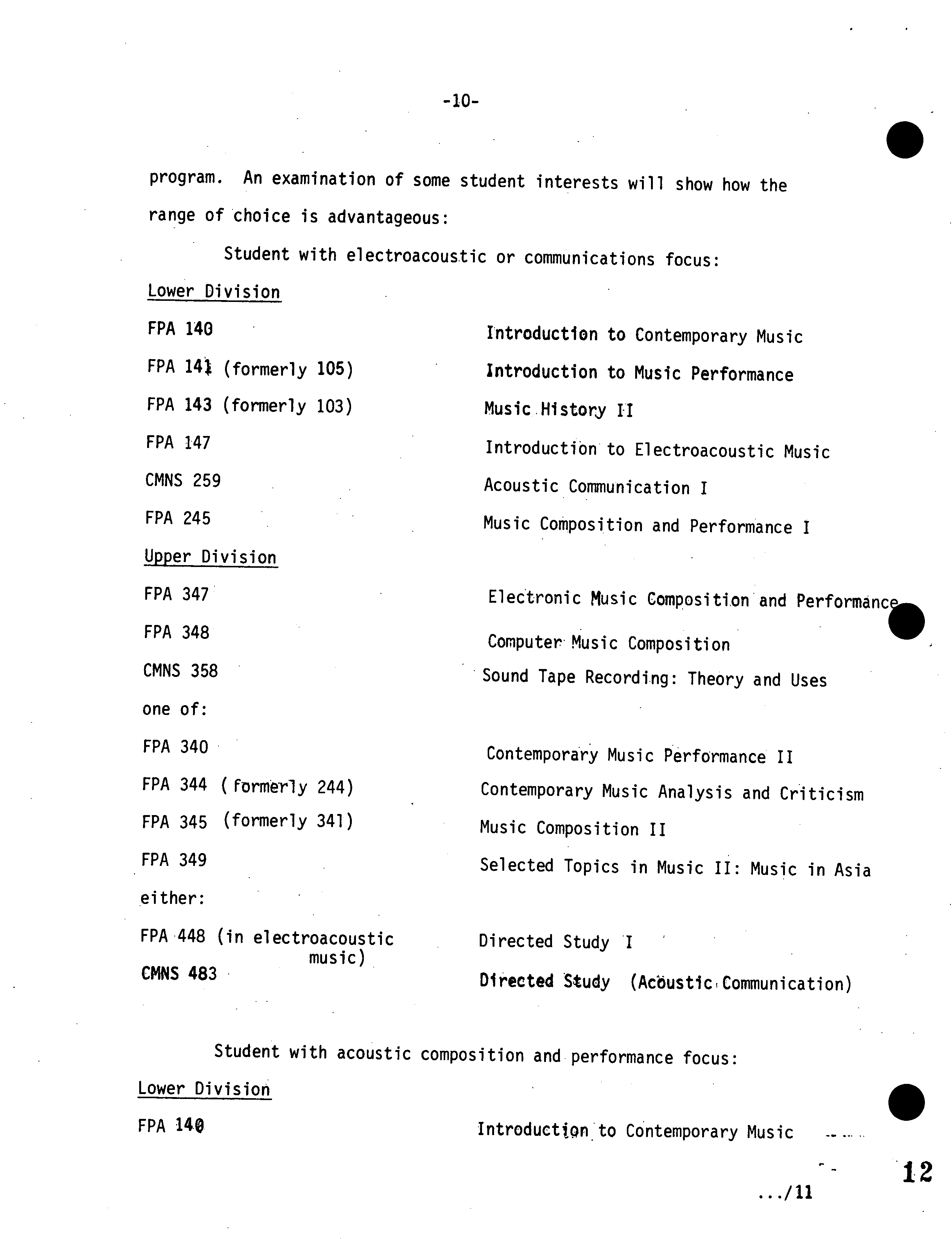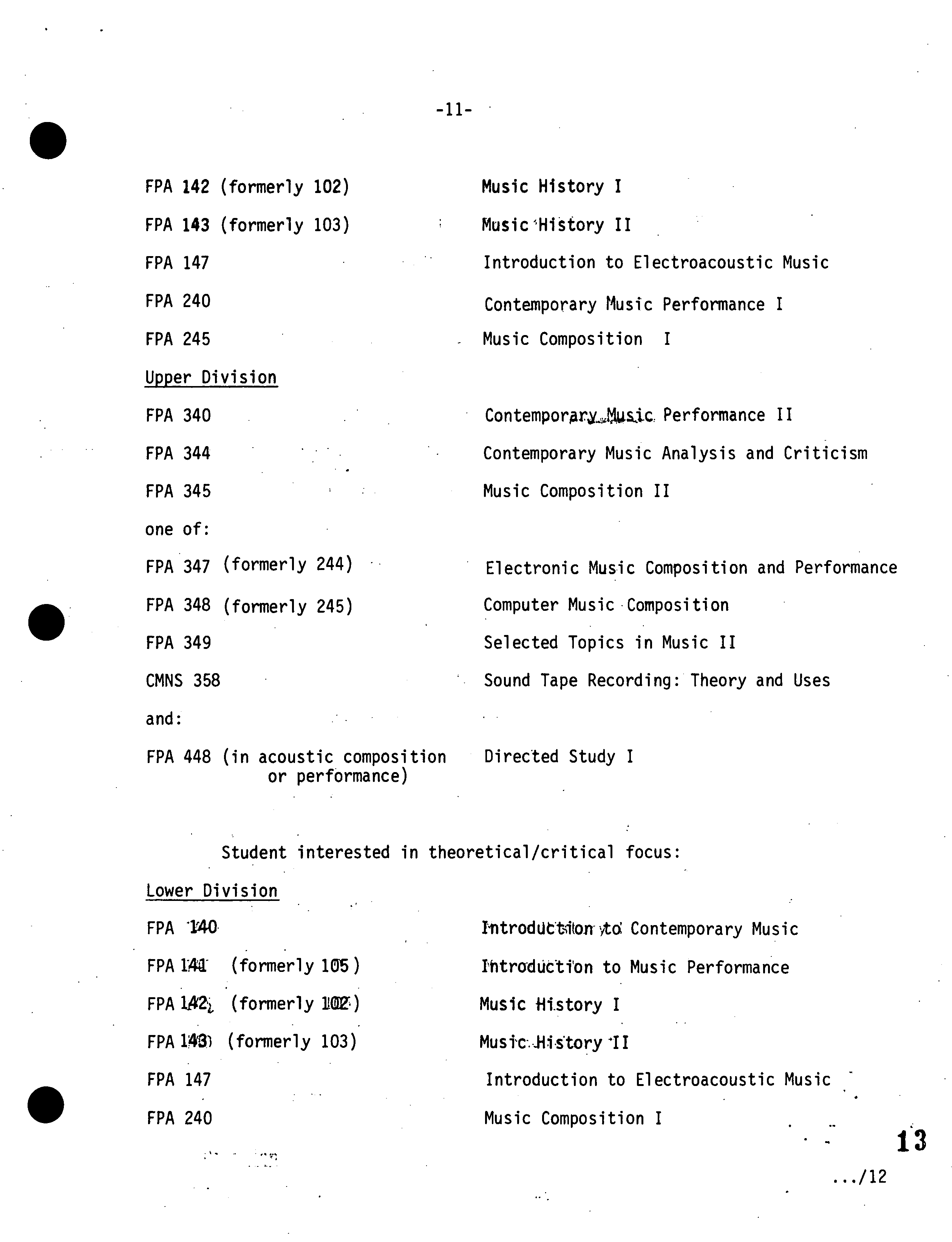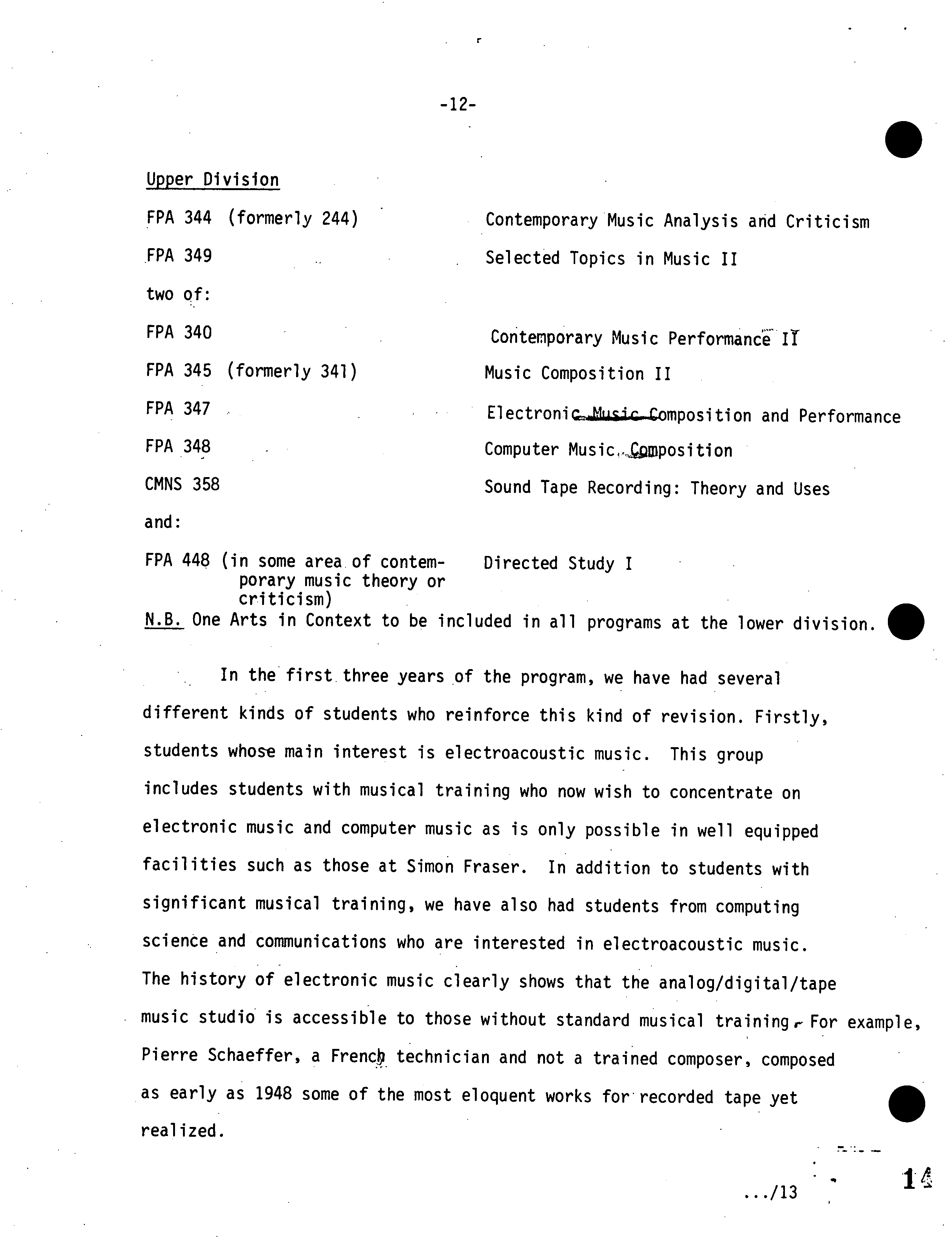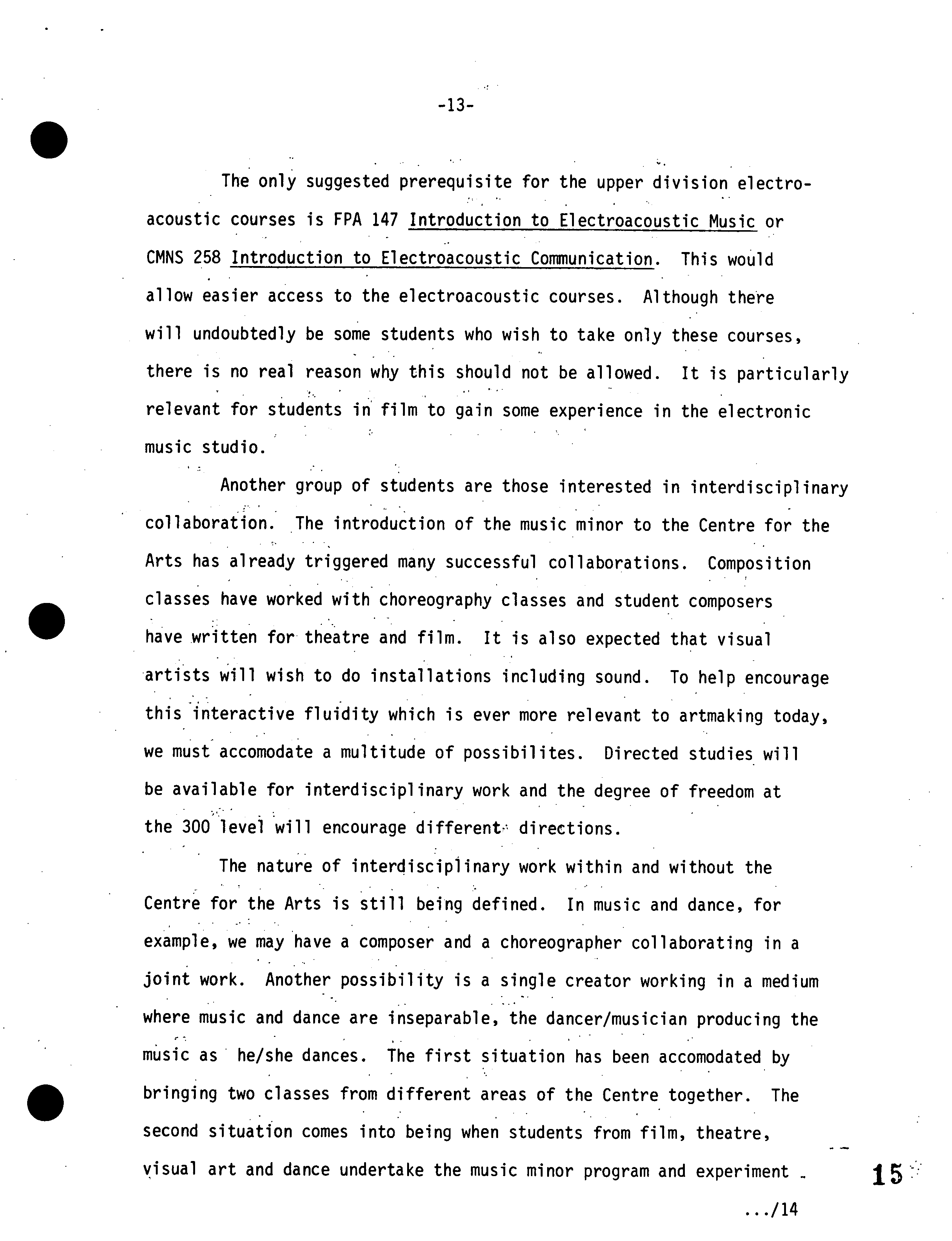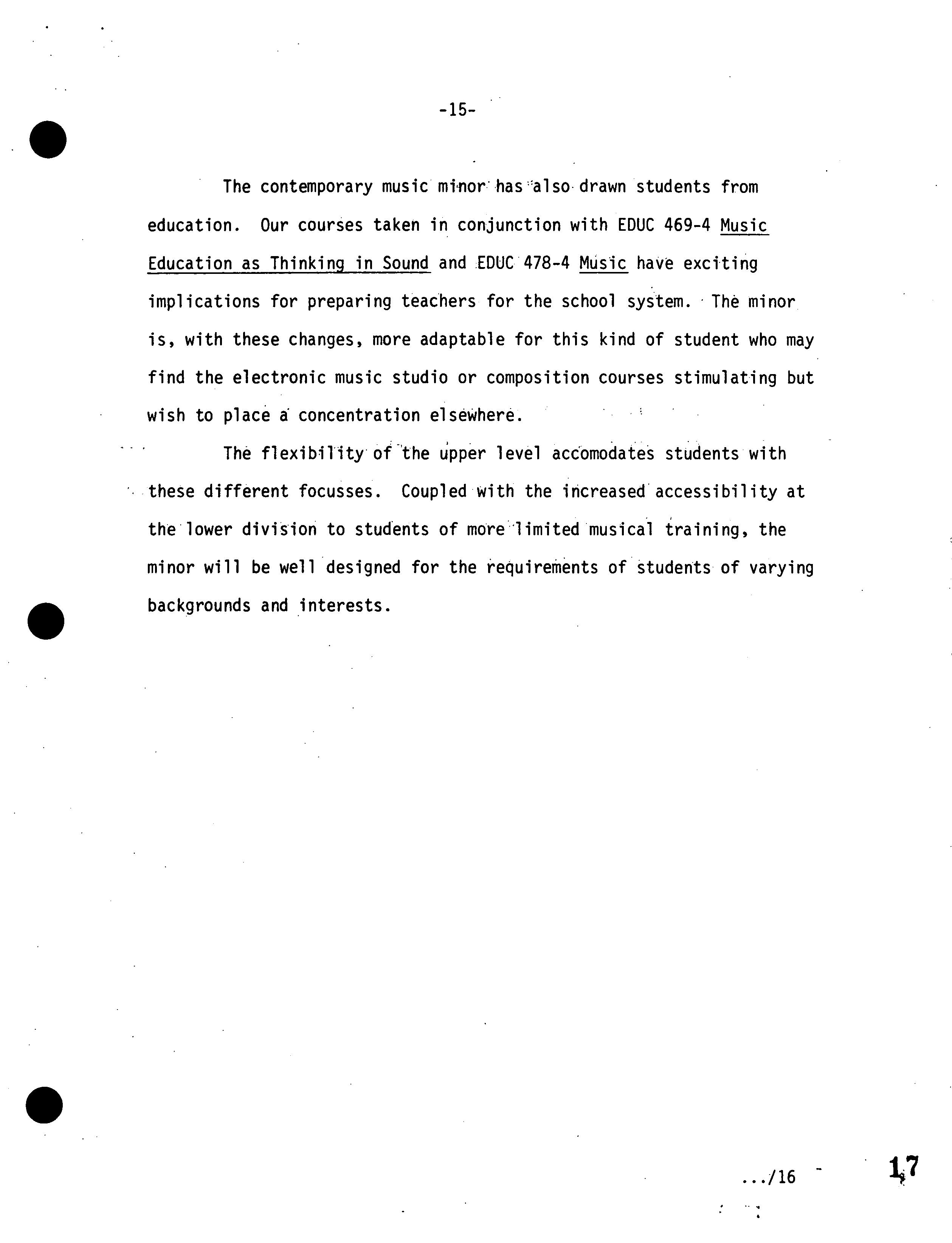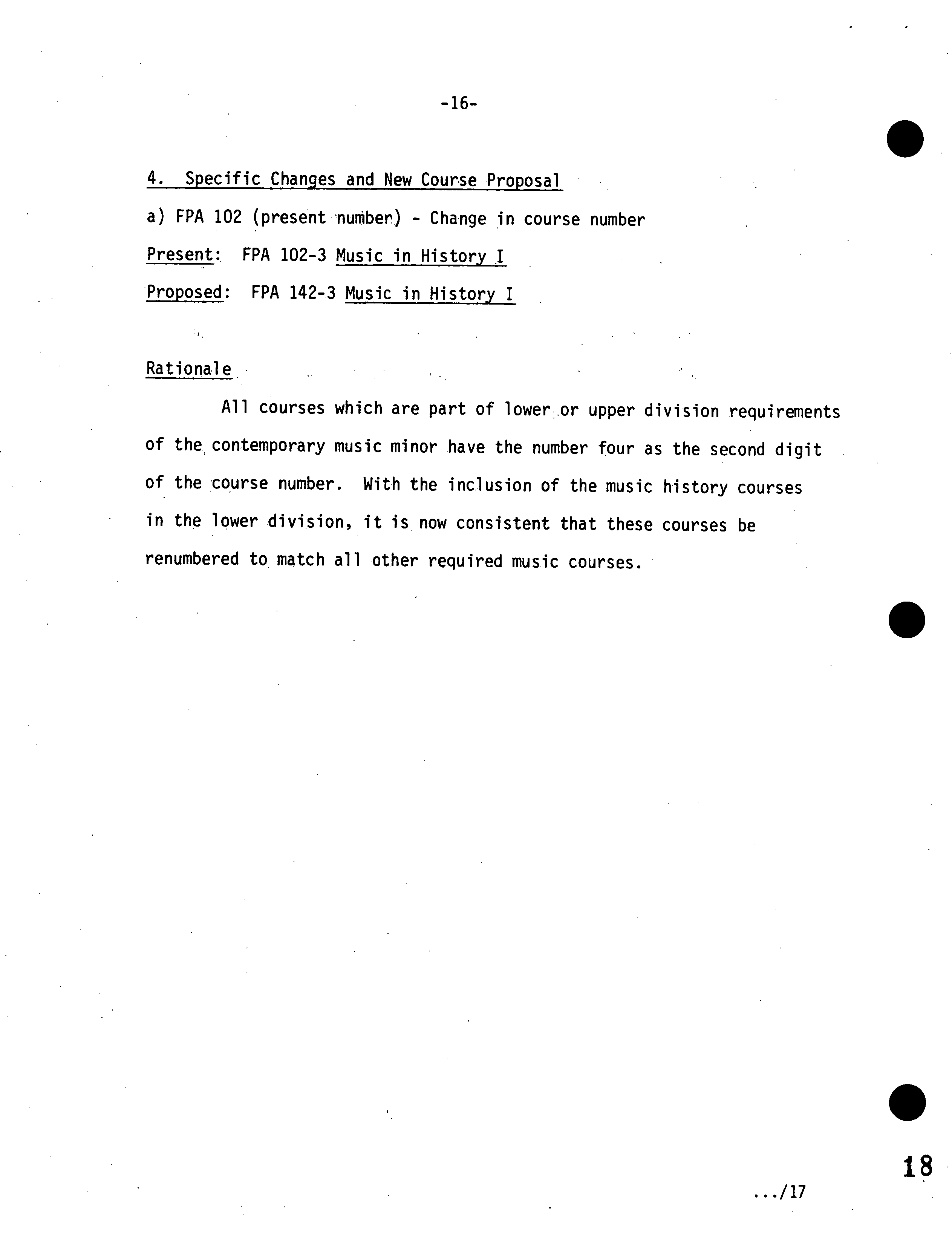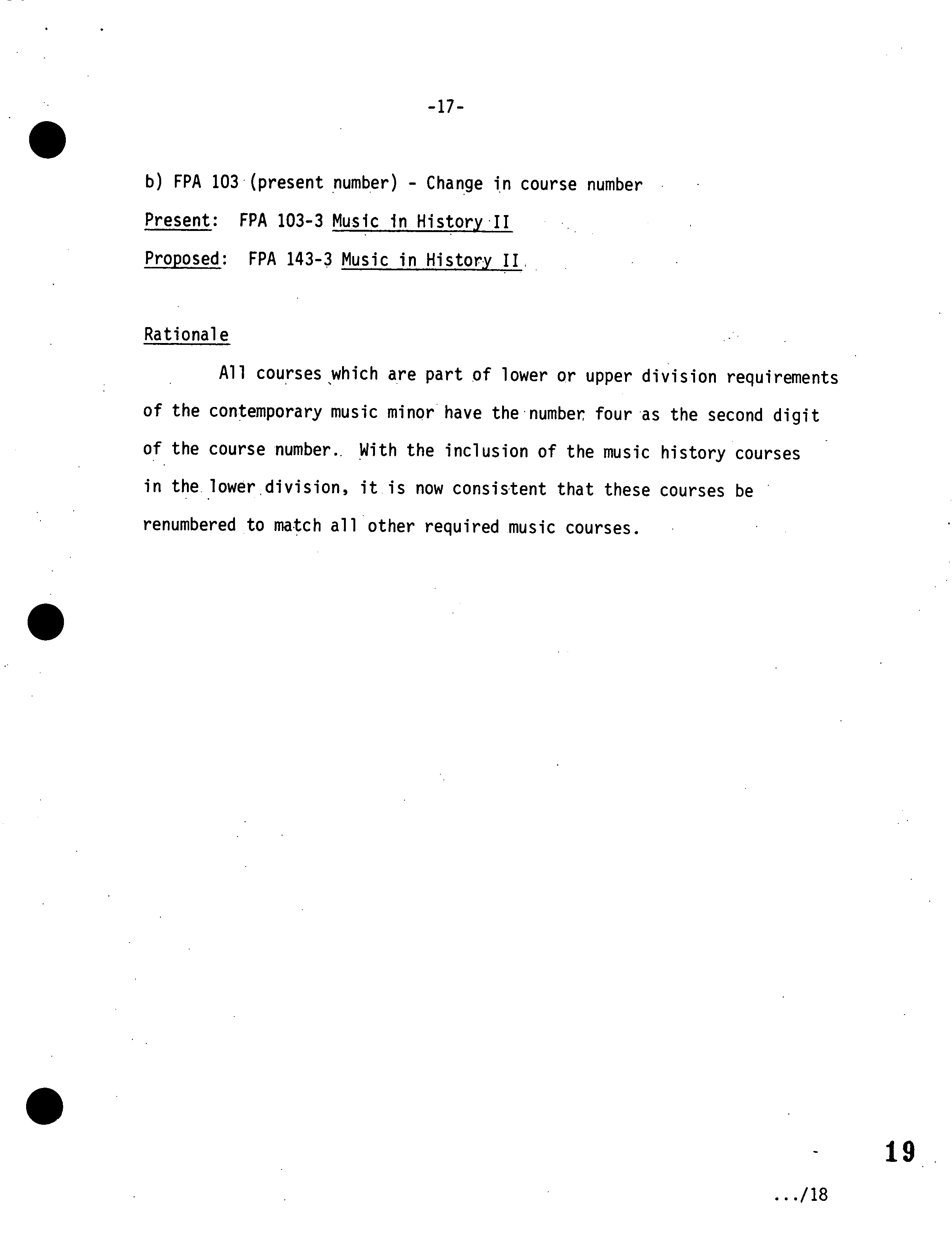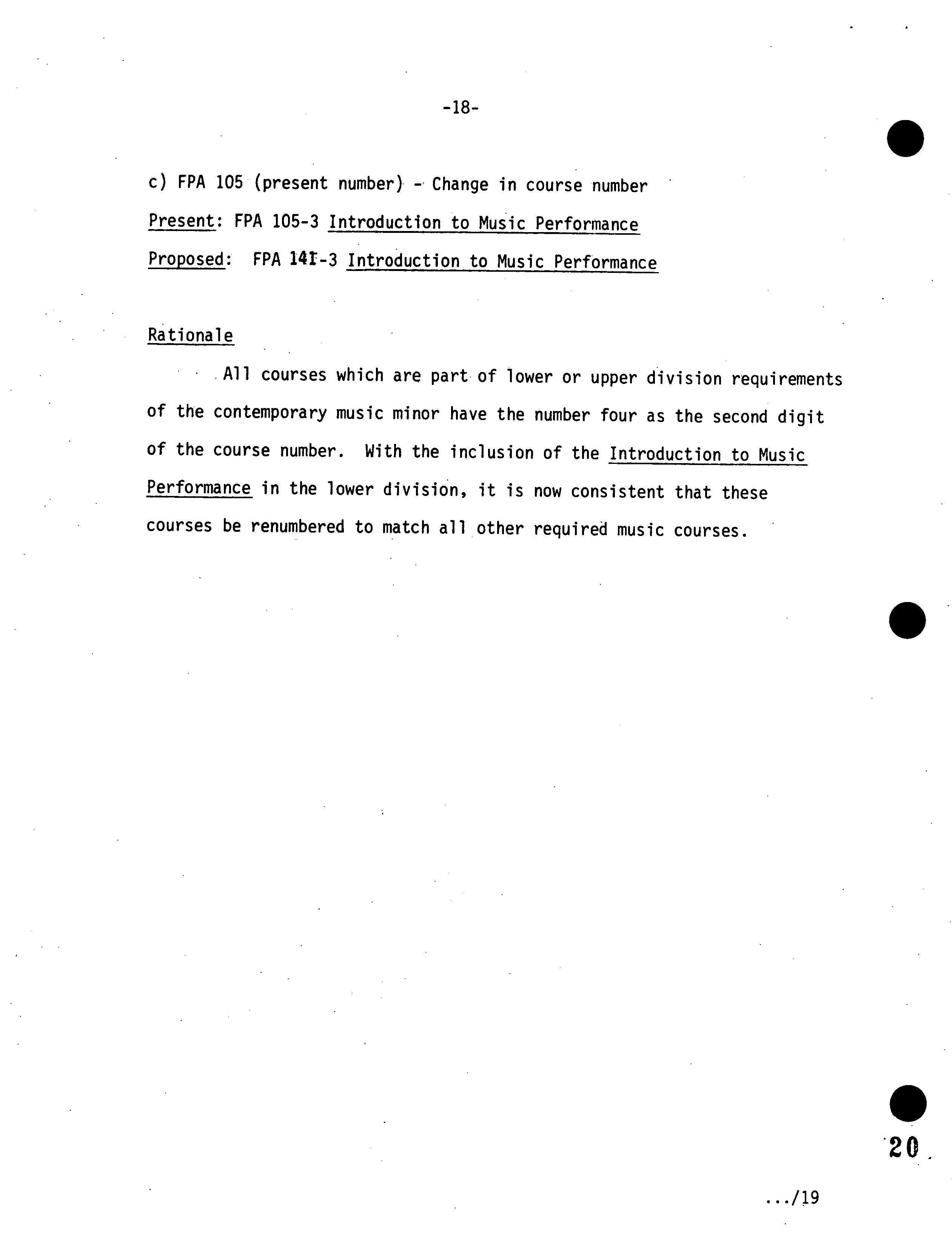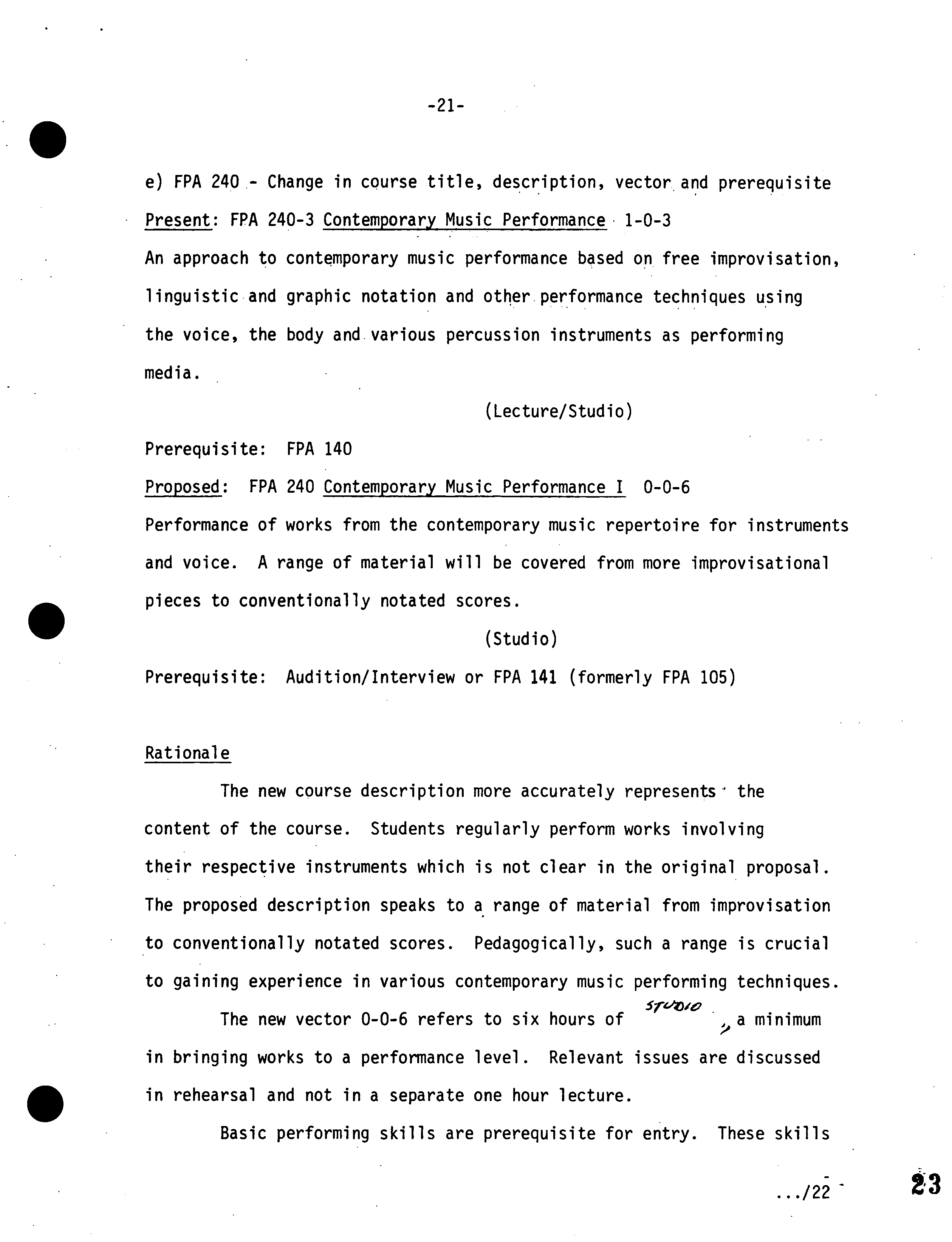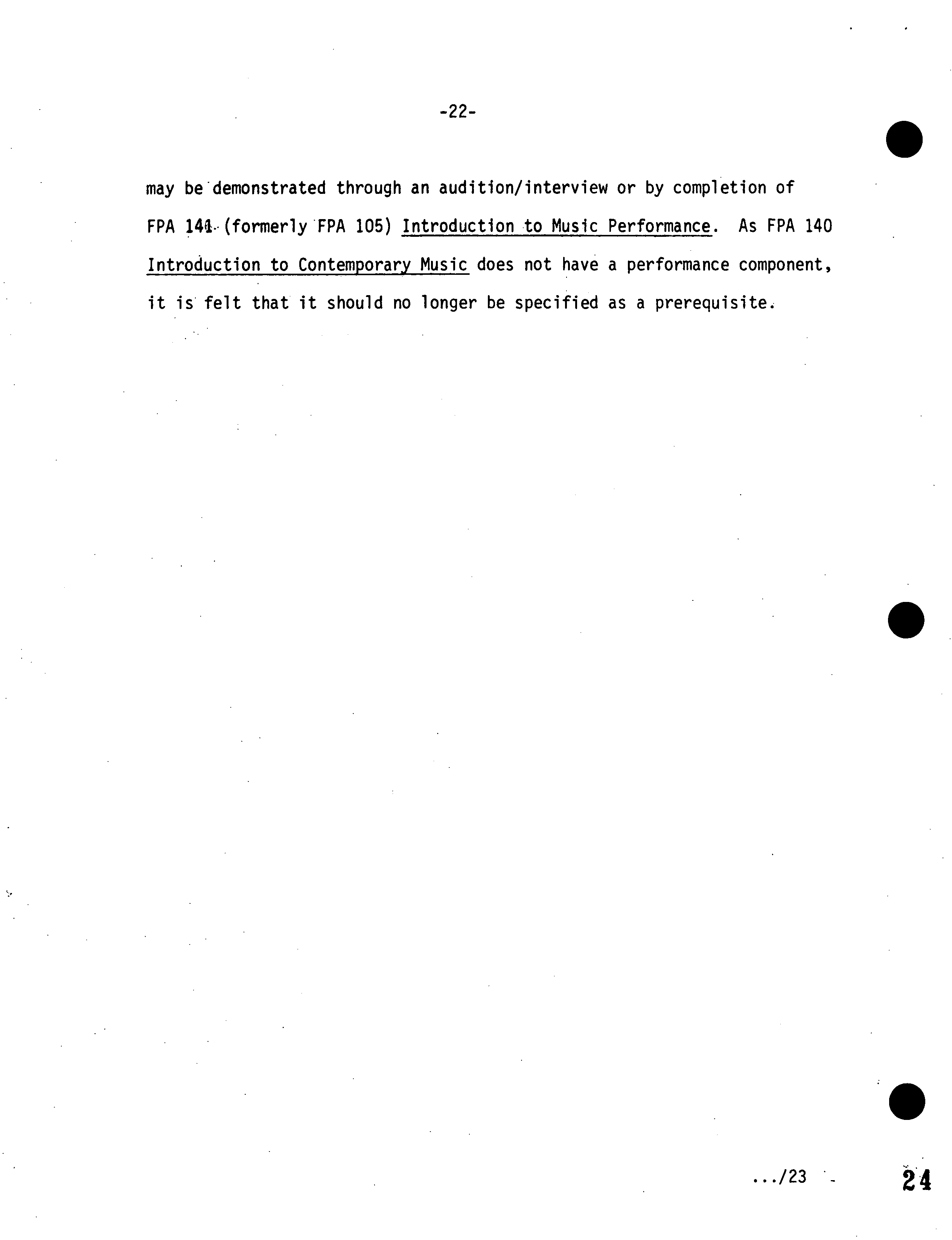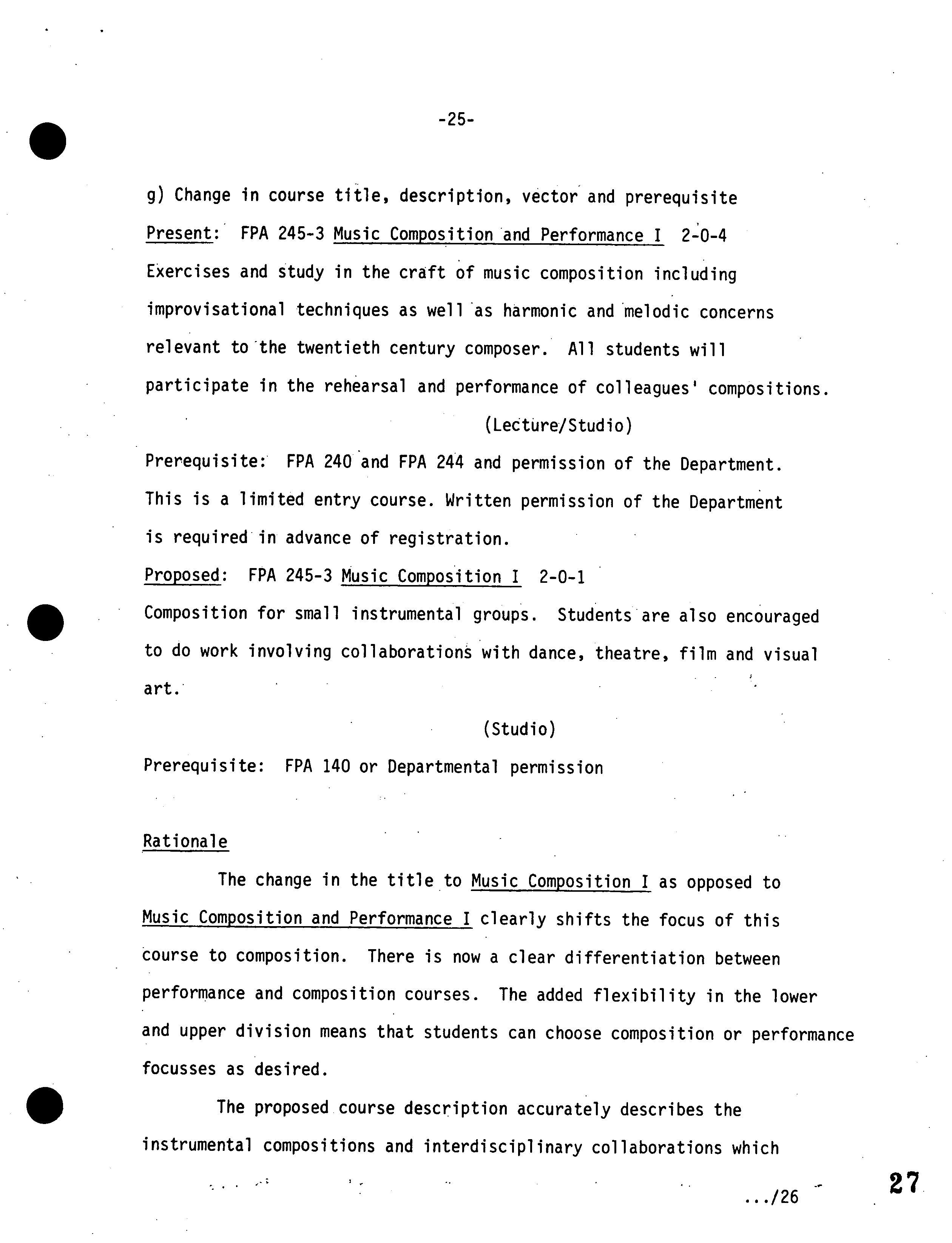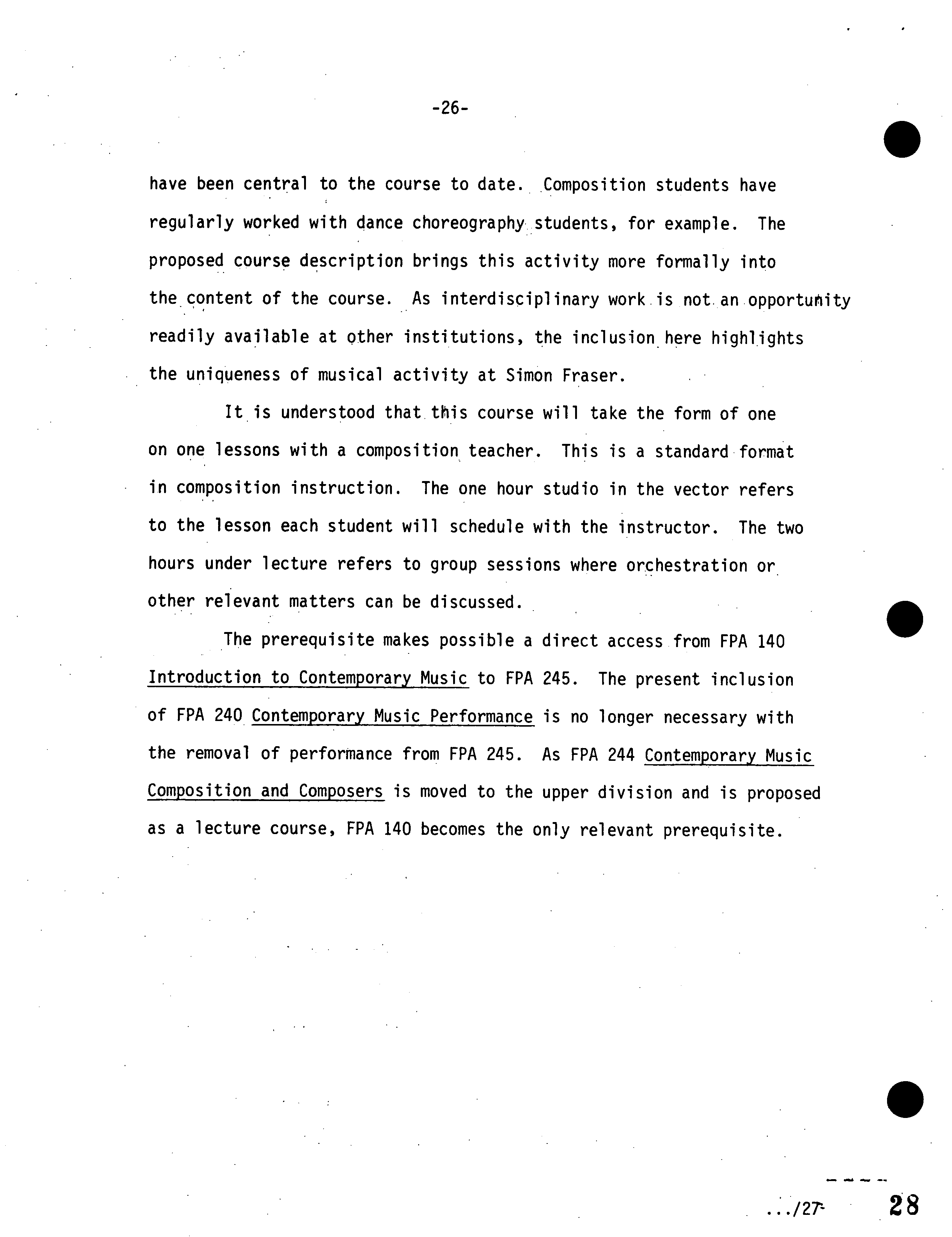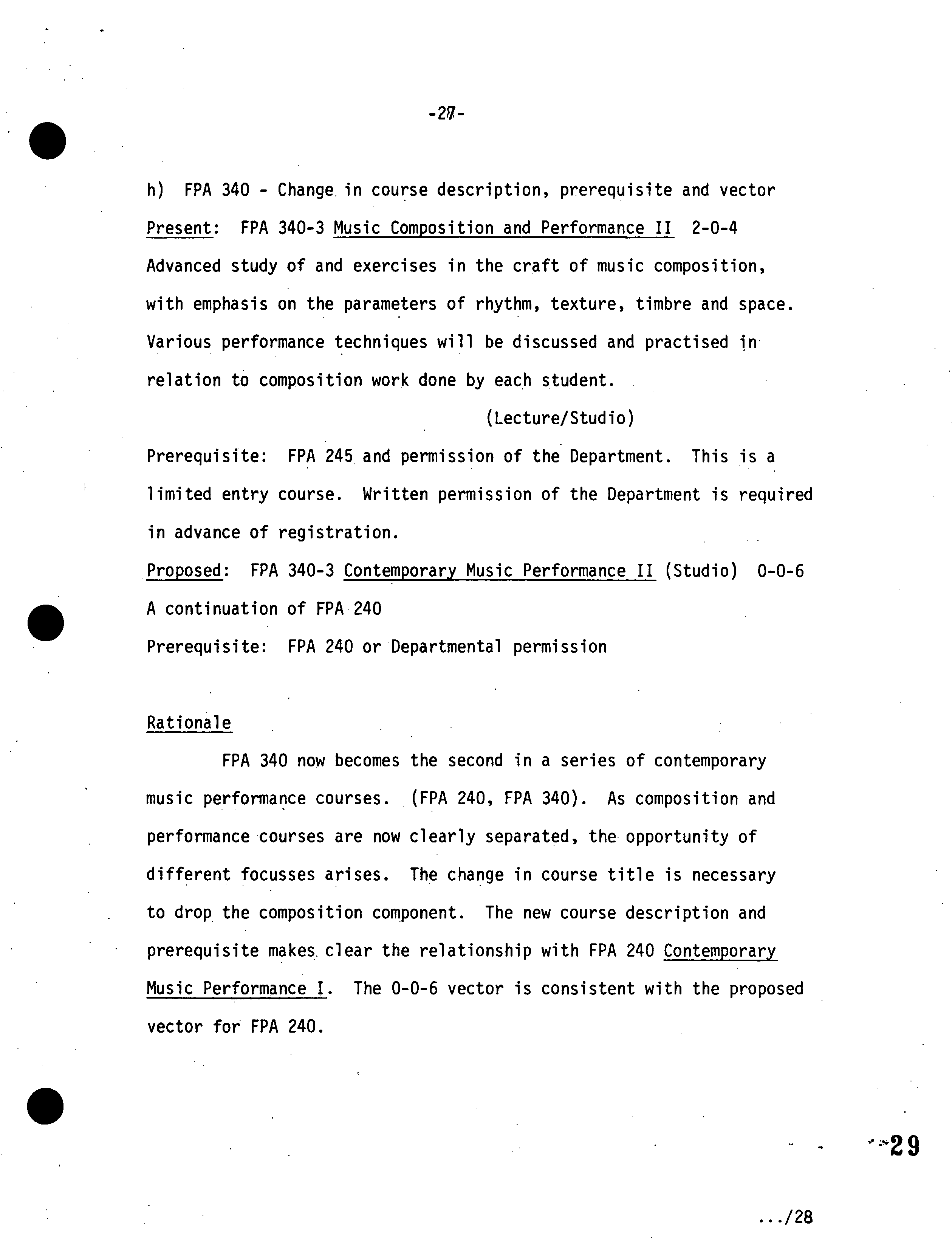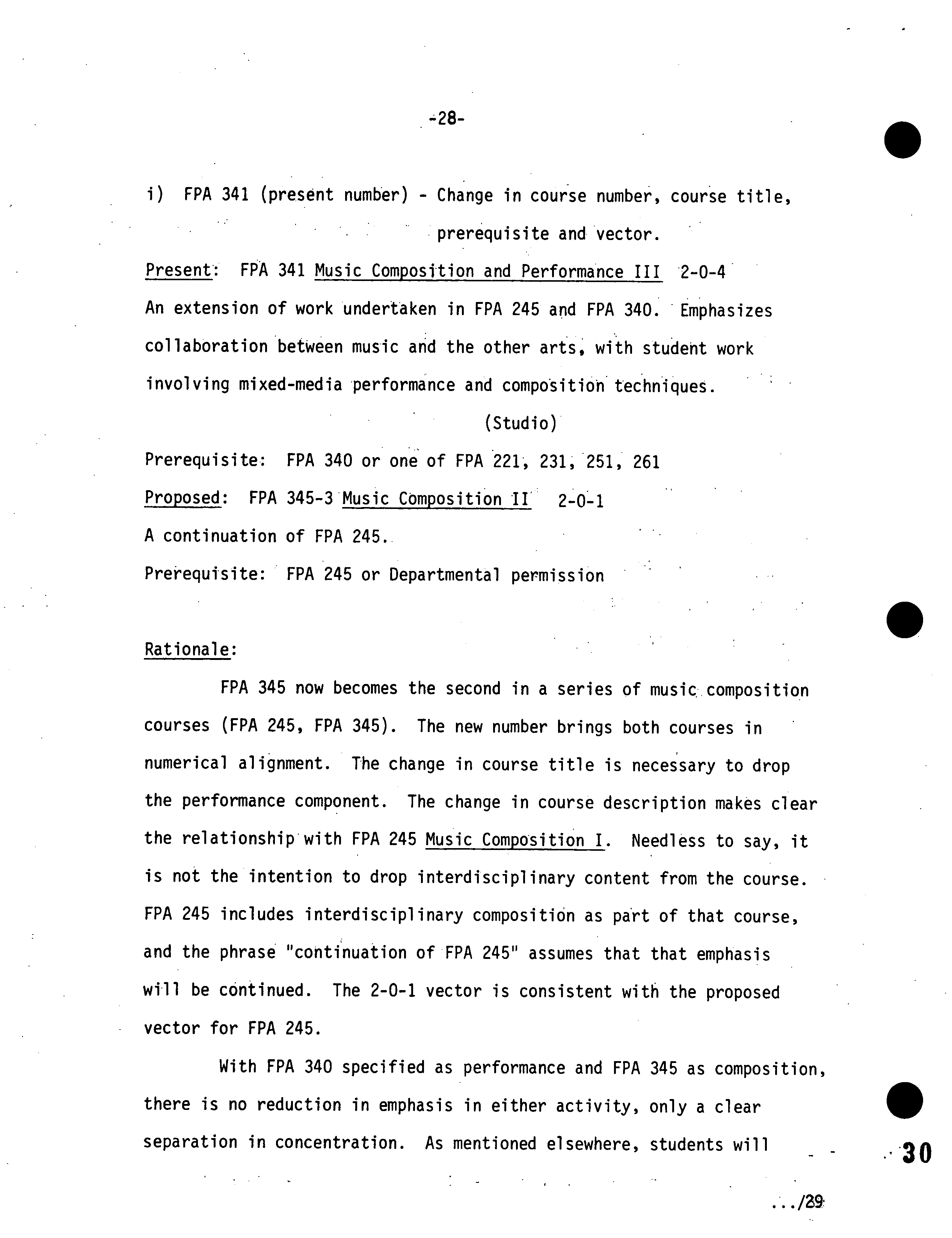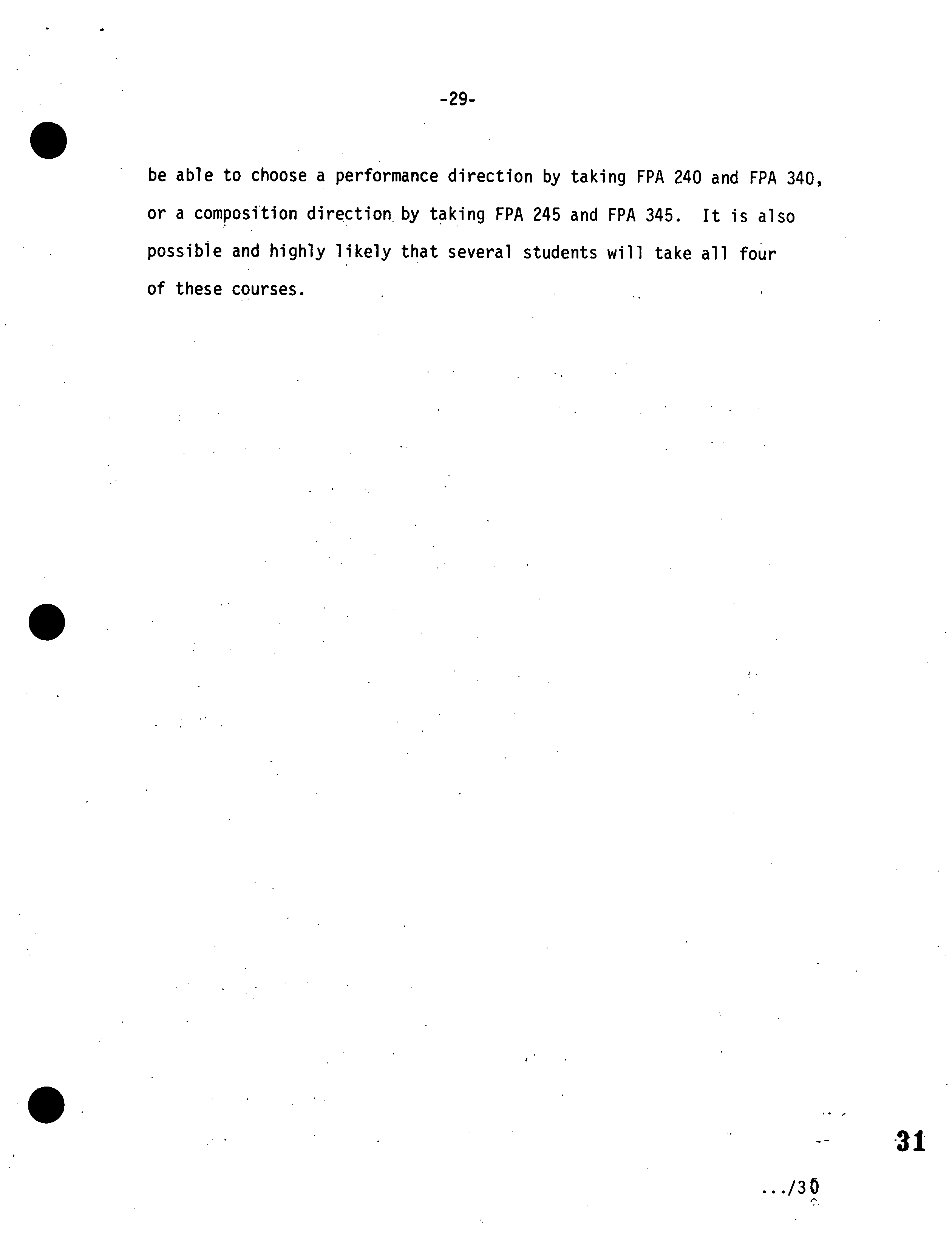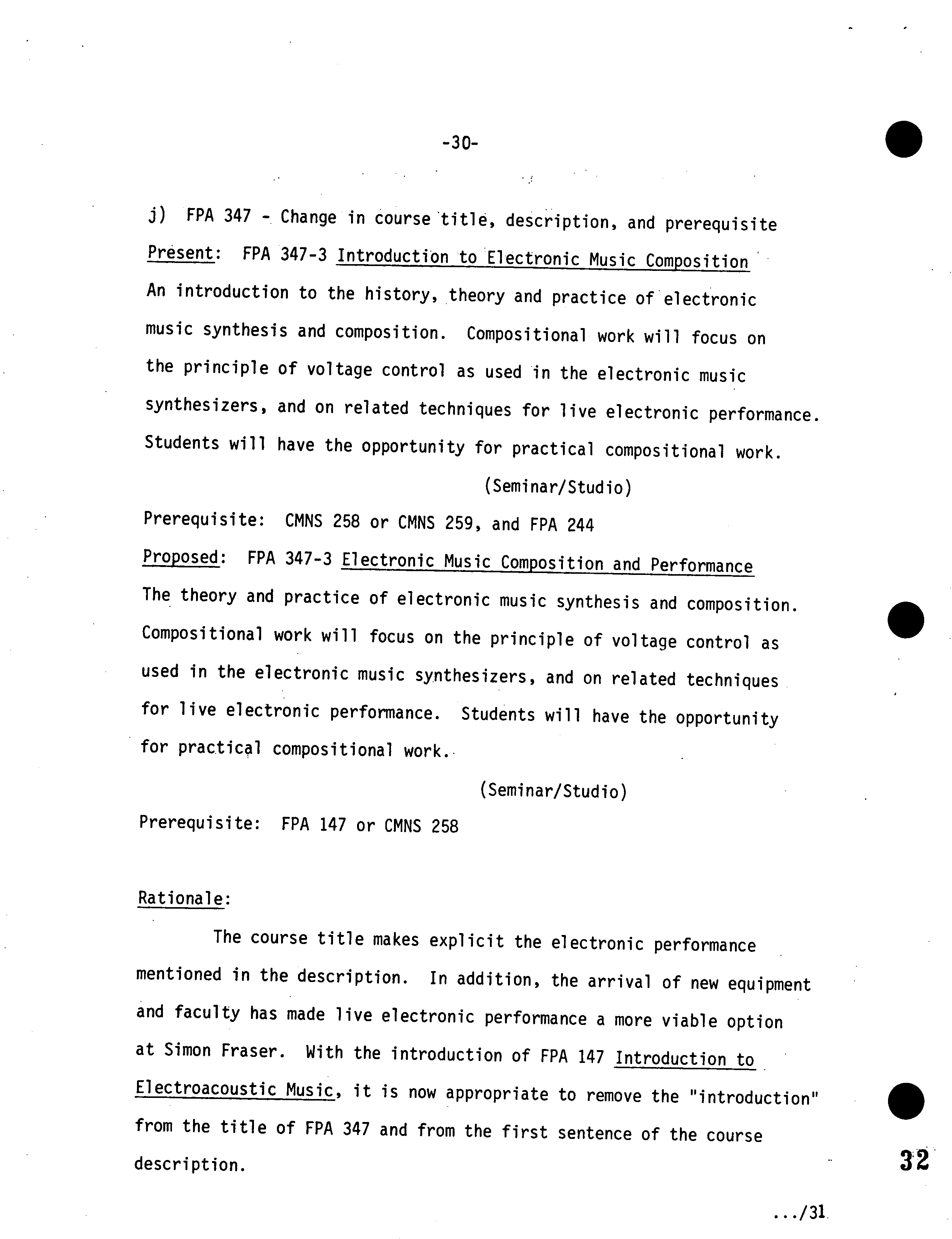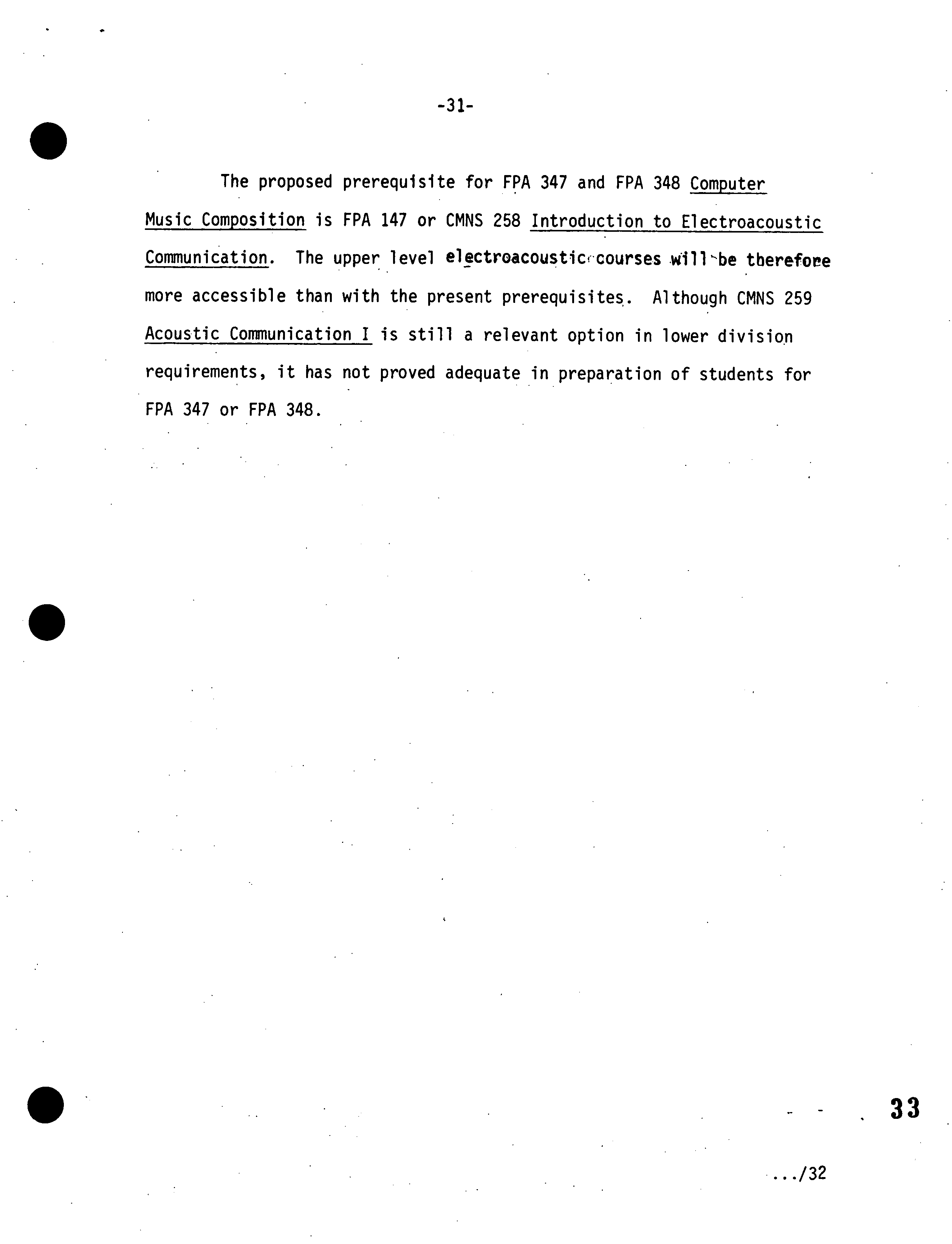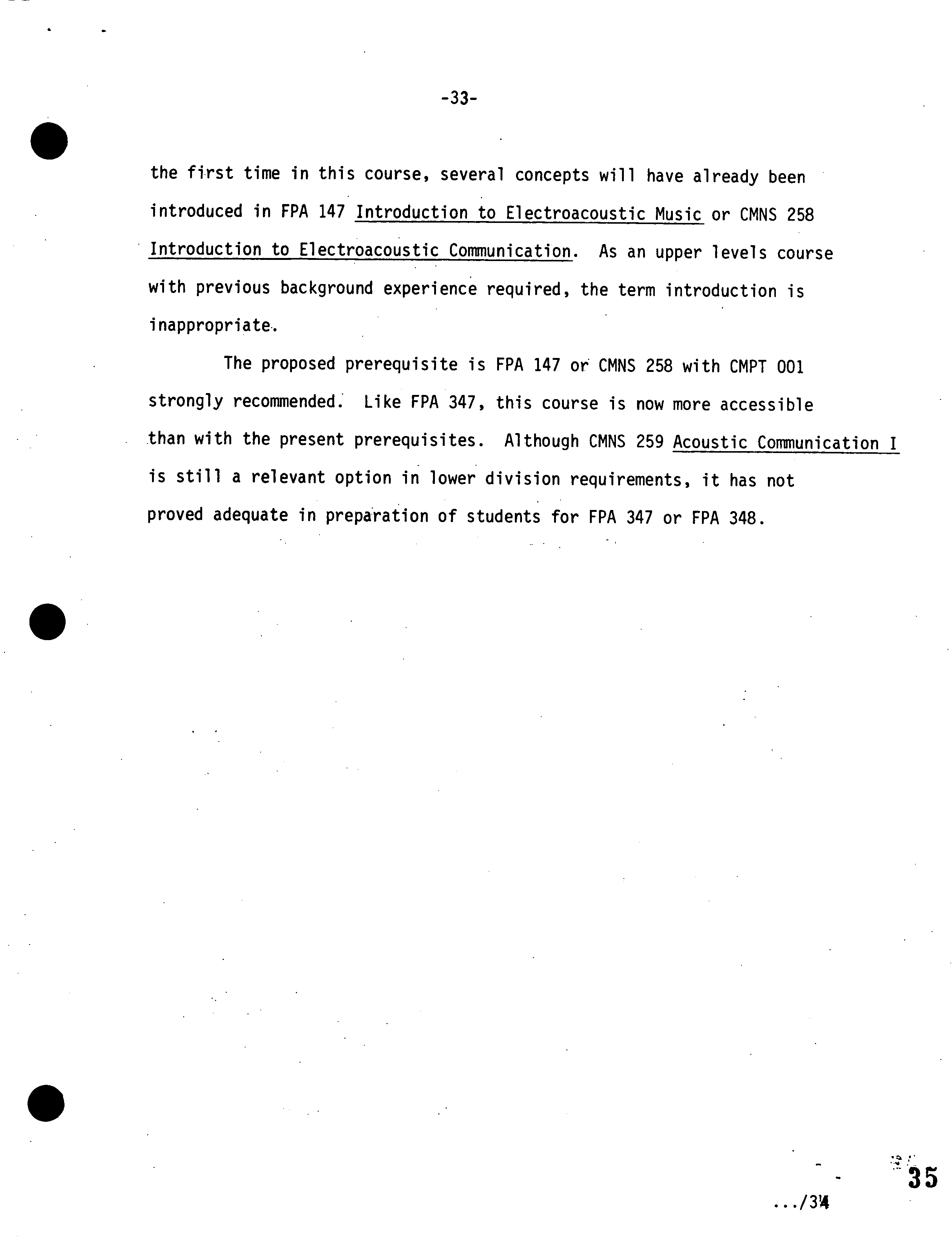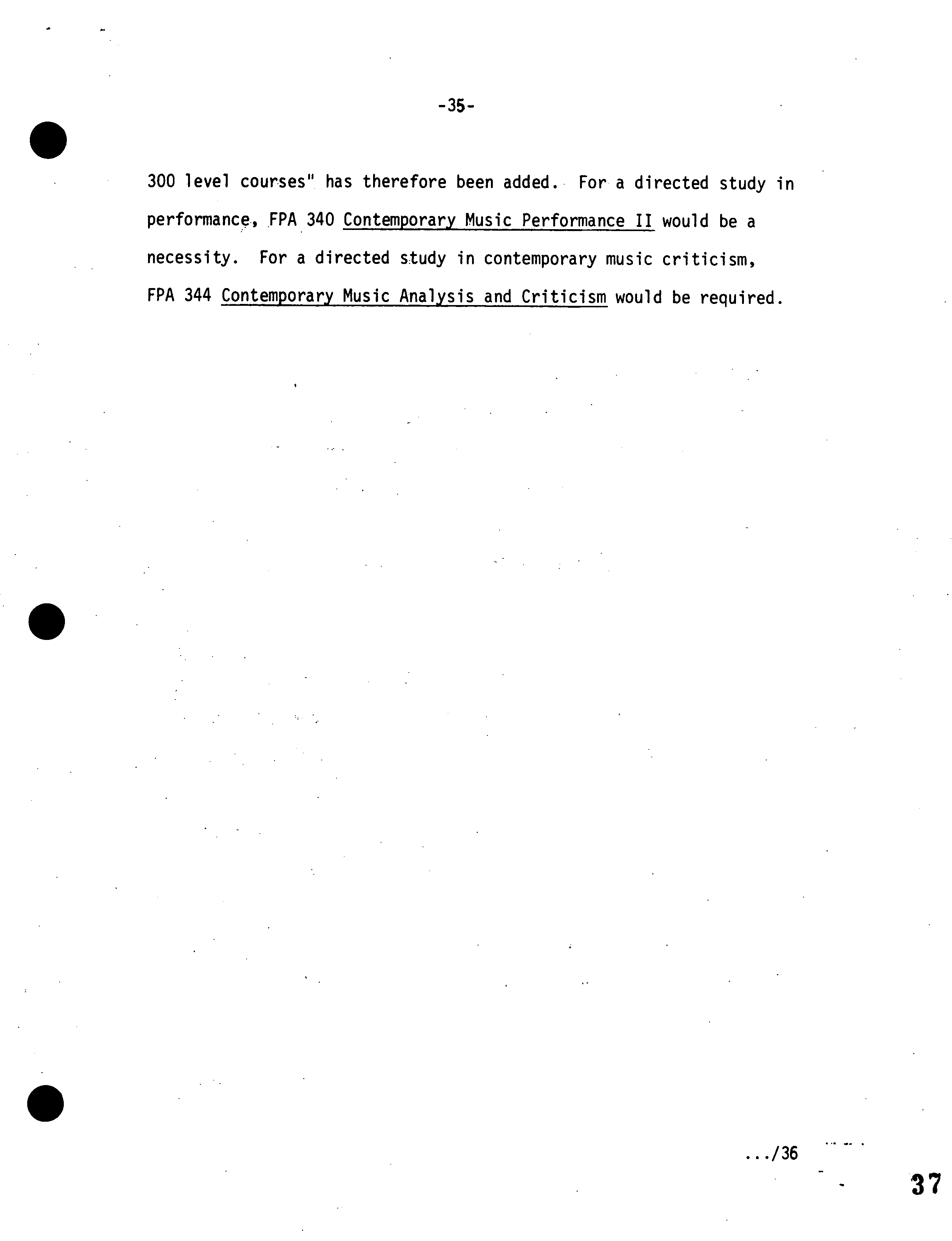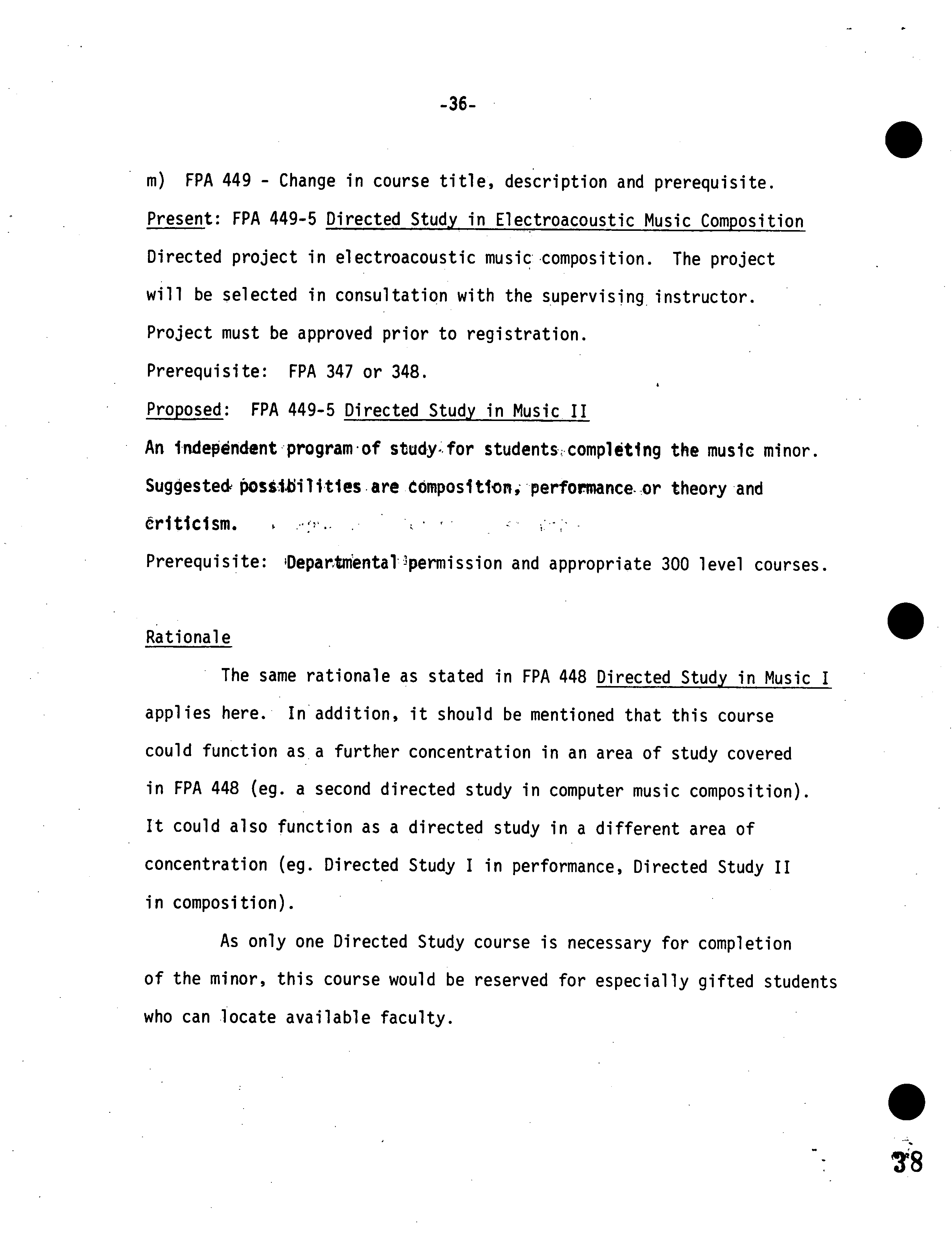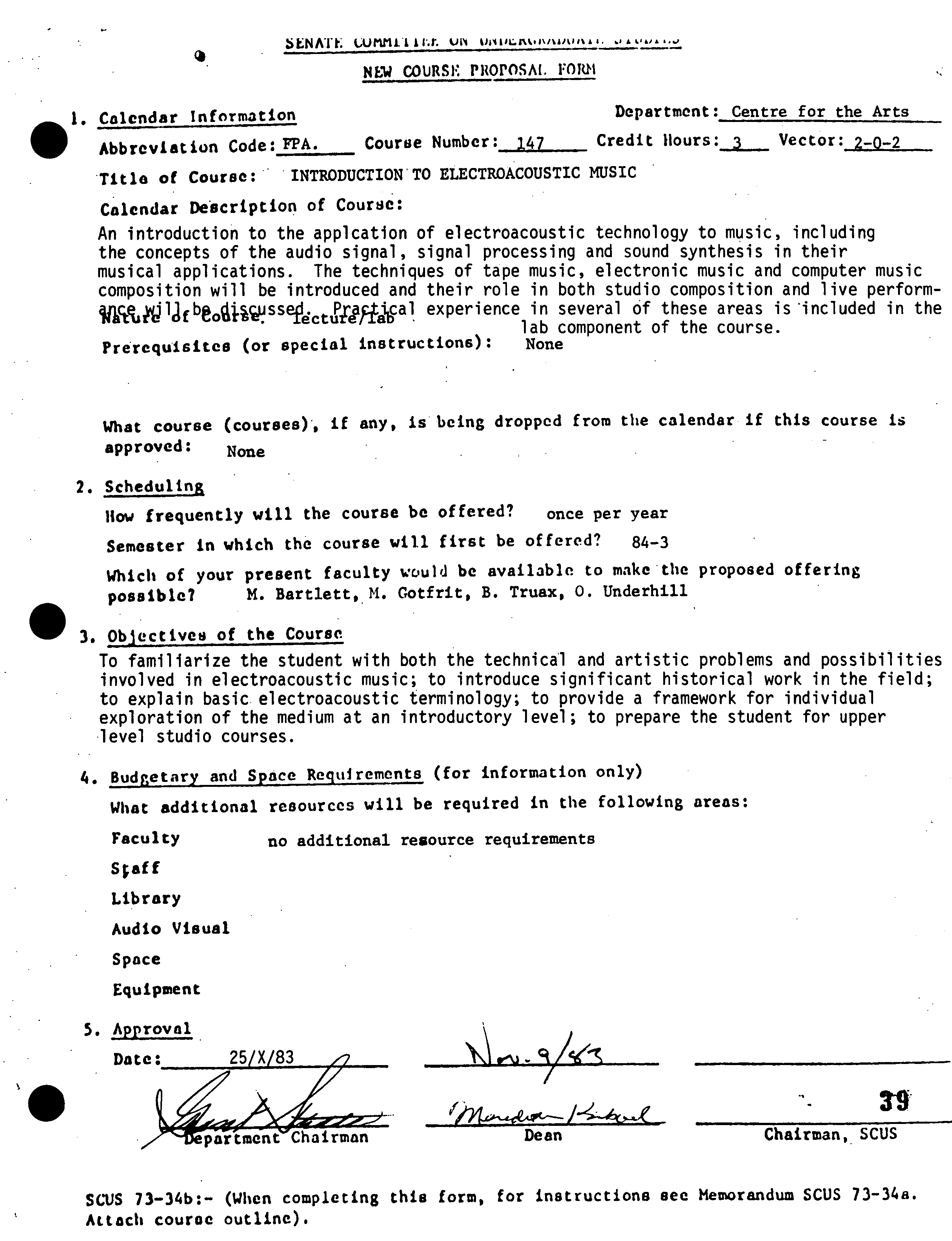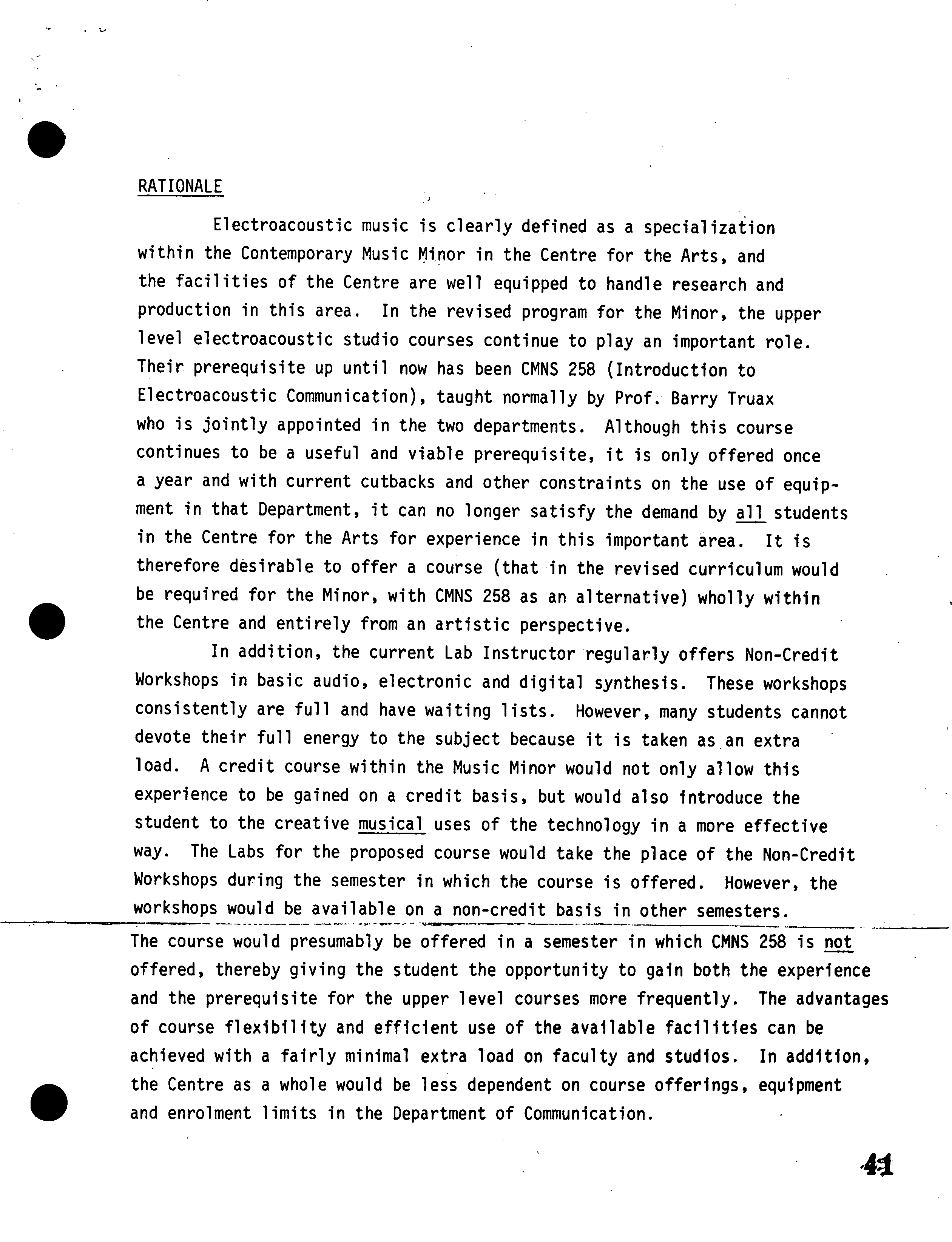SiMON FRASER UNIVERSITY
?
S.
3- 8
9
*
TO .....
I ...
SENATE ..
MEMORANDUM
From
SENATE COMMITTEE ON UNDERGRADUATE
'thi±
Ed:
.......................
S
Sub
jid
?
CHANGES - CENTRE FOR THE
IRT.:.
?
Date.....
7. ?
...........................
FOR INFORMATION:
Acting under delegated authority at its meeting of November 15,
1983 the Senate Committee on Undergraduate Studies approved
change in prerequisite for FPA. 384-3 - Criticism of Performance
by adding requirement "At least 45 semester hours credit or
permission of the Department".
Action undertaken by the Senate Committee on Undergraduate Studies at its
meeting of November 15, 1983 gives rise to the following motion:
MOTION: "That Senate approve and recommend approval to the Board
of Governors, as set forth in S.83-89 , the proposed
changes in the Contemporary Music Minor, including:-
i)
Contemporary Music Minor as proposed - (pages 6-8)
ii)
List of changes in lower division requirements and
in upper division requirements - (page 9)
iii)
Specific changes - (pages 18-38)
iv)
New course FPA. 147-3 - Introduction to Electroacoustic Music"
The committee noted that the proposed changes in this minor program are
quite extensive; that the proposal is clear and well-prepared; that there
is not requirement of additional resources although there is expectation of
enrollment increases. The proposal provides much greater flexibility than
at present, it is less restrictive in requiring composition and provides
more opportunity than at present for those with performance or criticism
interests, and it presents easier and clearer routings.
0
SiMON FRASER UNIVERSITY
'
^C
61,
r
0
3-
MEMORANDUM
•o ?
Mr. H. M.
Eyis
?
an..
From.
Janet Blanchet 7
Secretary to the
tary to the Senate Committee on
............ère
?
1acu1ty o tntei kliIplInãry
sc
tüdIè
........
?
gr4ua...Studiçs.
...
?
.c
T.icl.l1n
Subject.
?
Date.
••
N9y
e
fl1ber
9/83
Minor.
?
I
Centre for the Arts Curriculum.
(ISC 83-27).
At a meeting of the Faculty of Interdisciplinary Studies
Undergraduate
Curriculum
Committee held on Tuesday, November 8, 1983 members
of the committee approved the revision of the Contemporary Music Minor in
the Centre for the Arts as set forth in the attached paper. This package
contains the following:
Introduction.
?
P. 1
Present
and Proposed Contemporary
Music Minor. ?
p. 3
List of changes to lower
and upper
division requirements. ?
p. 7
•
? Rationale. ?
p. 8
Specific changes
and new
course
proposal,
FPA
147-3, Introduction
to Electroacoustic Music. ?
p. 16
Would you please place this paper on the next agenda of the Senate Committee on
Undergraduate Studies for consideration.
Enclosure. ?
-T
S
1
L.C.
?
-t7.
REVISION OF CONTEMPORARY MUSIC MINOR
I. Introduction
2.
a) Present and Proposed Contemporary Music Minor
b) List of Changes to Lower and Upper Division Requirements
3. Rationale
4.
Specific Changes and New Course Proposal
.
S
2
• ?
1. Introduction
The contemporary music minor is now in its third year of full
time operation. The last full time faculty appointment came into effect
in September 1982, and the coming spring semester will include our
first graduates. Although the minor is in its early stages, the music
area of the Centre for the Arts and the Centre itself feels that now
is an appropriate time for review and subsequent curricular adjustment.
The program now in place has already been successful in its
composition specialization in drawing gifted students with extensive
previous musical experience who seek opportunities not available at
other institutions. As the program becomes better known, we, expect to
continue to draw on such students who are currently in the upper levels
of the program; several transfer students from the colleges and mature
students and musicians who recognize the unique nature and relevance of
the contemporary music minor. But adjustments presented here recognize
that a minor program's core student body should be drawn from those with
a wide range of interests who seek this program in conjunction with
another primary concentration of study. (eg. Dance major/Music minor;
Computing Science major/Music minor; B.Ed. with, music minor).
The following proposals acknowledge certain premises. Firstly,
that
,
our minor program should, in principle, be accessible to students
without prior extensive musical training. In an effort to make this
possible, it is necessary to establish a program that is truly a 'minor'
program; a program not so specialized or dependent on musical skills
0.
?
that it does not draw on students
in
the Centre for the Arts or the
- ?
3
-2-
university at large who wish to study contemporary music as a secondary
area of concentration.
As a second premise, the broadening of the composition base
seems now to be a positive step toward securing a regular enrollment for
the minor in future years. The proposal therefore is intended to create
more flexibility and would allow for concentrations in performance and
theory/criticism in addition to acoustic and electroacoustic composition
already offered. Changes in the prerequisite structure will facilitate
student passage through the program. Performance and composition courses
are accessible for interdisciplinary collaboration and electronic studio
courses available with reduced prerequisites. These changes in pre-
requisites should encourage more students to continue into the upper
division and complete the minor. More flexibility will allow students
who have an interest in technological expertise or interdisciplinary
collaborations, for example, to take those courses specific to their
needs
These proposals create great freedom within the minor and
make possible a plurality of specialization. In conjuction with the
planned graduate program in contemporary music, these two programs
constitute one of the few curricula in Canada addressing the role of
contemporary music and technology in society in a systematic and thought-
ful manner.
4
.
-3-
S
2. a) Present and Proposed Contemporary Music Minor
Present
Lower Division Requirements - as prerequisites
21 credit hours, distributed as follows:
all of:
FPA 140-3' ? Introduction to Contemporary Music
EPA 240-3
?
Contemporary Music Performance
FPA 244-3 ?
'
?
Contemporary Music Composition and -
Composers
EPA 245-3 ? Music Composition and Performance I
one of:
CMNS 258-3 ? Introduction to Electroacoustic
Communication
CMNS 259-3 ? Acoustic Communication I
one of:
FPA210-6
?
"
The Arts in Context: The Renaissance
EPA 212-6
'
?
The Arts in Context:
Baroque and
Enlightenment
FPA 213-6 ?
'
The
Arts in Context:
Romanticism
FPA 214-6
,
?
The Arts in Context:
Modernism
EPA
215-6
The Arts in Context: The Contemporary
Period
Upper Division Requirements
17 credit hours, distributed as follows:
FPA 340-3 ?
Music Composition and Performance II
FPA 341-3 ?
Music Composition and Performance III
one of:
FPA 347-3 ?
,
?
Introduction to Electronic Music
Composition
?
.'
I
.14
rr
KIM
FPA 348-3 ?
Introduction to Computer Music Composition .
one of:
CMNS
358-3
Sound Tape Recording:
Theory and Uses
CMNS
359-3
Acoustic Communication
II
one of:
FPA 448-5 ?
S
Directed
Study
in Music Composition
FPA 449-5
Directed
Study
in Electroacoustic Composition
CMNS 483-5
5 ?
Directed
Study
(Acoustic Communication)
Proposed
Lower Division Requirements - as prerequisites
24 credit hours, distributed as follows:
18 credit hours, chosen from:
FPA
i'w-s
Introduction to Contemporary Music
*FPA
141-3
Introduction to Music Performance
**FPA
142-3
Music History I
***FPA
143-3
Music History II
****FPA
147-3
Introduction to Electroacoustic Music
CMNS
258-3
Introduction to Electroacoustic Communication
CMNS 259-3
Acoustic Communication I
FPA
240-3
Contemporary Music Performance I
FPA
245-3
Music Composition I
FPA
249-3
Selected Topics in Music I
Including
at least one of:
FPA 142-3 ?
Music History I
? -
FPA 143-3 ?
Music History II
?
- ?
6
./5
-5-
S
at least one of:
EPA 141-3
?
Introduction to
?
Music Performance
EPA
240-3
?
Contemporary Music Performance
at least
one of:
EPA 110-3
?
Introduction to Contemporary Music
EPA 245-3
?
Music Composition I.
.
S
at least one of:
EPA 147-3
Introduction ?
to
?
El
p
ctro;!r: custjc; 1jj
2S-3
Inty-oductino
?
to
COnziication
plus
one of:
EPA 210-6
The Arts in Context:
The Renaissance
FPA 212-6
The Arts in Context:
Baroque and
?
Eriliçttern;crit
EPA 213-6
The Arts in Context:
Romanticism
FPA 214-6
The Arts-in Context:
Modernism
EPA 215-6
The Arts in Context:
The Contemporary Period
* formerly EPA 105
** formerly FPA 102
*** formerly EPA 103
new cousn describel elsewhere in proposal
Upper Division
Requirements
17 credit hours, distributed
as ?
follows:
EPA
340-3
Music Composition
and
Perfonaiirce U
EPA
341-3
Music Compoitio ?
and
Pe .
rfo'atj ?
]J1I
one of:
EPA 347-3
?
Introduction to Electronic Music
Composition
?
7
FPA 348-3 ?
Introduction to
Computer Music Composition
one of:
CMNS
358-3 ?
Sound Tape Recording: Theory and Uses
CMNS 359-3 ?
Acoustic
Communication
II
one of:
FPA 448-5
FPA 449-5
f
?
s
CMNS
483-5
Up p
er Division
?
ements
17 credit hours, distributed as follows:
12icredjt hours chosen from:
?
FPA 340-3 ?
Cont
?
*FPA 3443
?
Cont
?
**FPA 3453
?
Musi
FPA 347-3
Directed Study in Music Composition
Directed Study in Electroacoustic
Composition
Directed Study (Acoustic Communication)
emporary Music
P
erformance II
emporary Music Analysis and Criticism
C
Composition
ii
-. ?
-
.
• ?
c.Iccr'on1c
MUS1C
Studio
?
FPA 348-3 ?
Computer Music Studio
?
FPA 349-3 ?
Selected Topics in Music II
?
CMNS 358-3 ?
Sound Tape Recording: Theory and Uses
one of:
FPA 448-5
FPA 449-5
CMNS 483-5
* formerly FPA 244
** formerly FPA.341
Directed Study I
Directed Study II
Directed Study (Acoustic Communication)
S
8
-7-
2. b) List of Changes to Lower and Upper Division Requirements
1)
24 credit hours required instead of 21
2)
Inclusion of EPA 102 (present number) Music History I
3)
Inclusion of EPA 103 (present number) Music History II
4)
Inclusion of FPA 105 (present number) Introduction to MusiC Performance
5)
New course proposed - EPA 147 Introduction to Electroacoustic Music
6)
Inclusion of EPA 249 Selected Topics in Music I
7)
EPA 244 Contemporary Music Composition and Composers moved to upper
division (with further changes in course content)
8)
Several changes in choice of requirements to create flexibility
Upper Division
9)
Inclusion of FPA 344 Contemporary Music Analysis and Criticism (new title)
10)
Inclusion of FPA 349 Selected Topics in Music II.
11)
CMNS 359 Acoustic Communication II dropped from requirements
12)
Several changes in choice of requirements to create flexibility
9
.
/8
-8-
S
3. Rationale
The introduction of the music history survey courses place-the
contemporary music program
in
an historical perspective.
?
Previously
these courses had been recommended and did not appear as requirements.
Although the advent of the electronic music studio and the work
of John Cage, the Fluxus group and others have made composition and
performance accessible to those without standard conservatory training,
the current period
in
its reexamination of traditional musical values
requires more than ever an historical foundation to creative music making.
The music minor now parallels film, visual art and dance with the
inclusion of these history courses.
The current program does not include FPA 142 Music History I
(formerly FPA 102), FPA 143 Music History II
?
(formerly FPA 103), FPA 104
5
Music Fundamentals or FPA 141 Introduction t6 Music Performance (formerly
FPA 105) as courses for lower division credit.
?
Students with little
performing expertise or knowledge of fundamentals or music history were
often directed to take several of these courses before being granted
admission to the lower division.
?
The preponderance of prerequisite
courses outside the minor has acted as a barrier to students without
substantial musical training.
?
With the introduction of EPA 141 Introduction
to Music Performance (formerly EPA 105) in addition to the history courses,
only FPA 104 Music Fundamentals is required as prerequisite to EPA 140
Introduction to Contemporary Music.
?
Students without fundamentals may
take EPA 104 while being granted immediate access to FPA 142 Music History I,
Of
EPA
the
143
lOOlevelcourses
Music History II,
included
and FPA 147
for}owerdvision
Introduction to
requirements,
Electroacoustic
only,Music.
5
10
S
S
S
TZ
FPA 141 (formerly EPA 105) Introduction to Music Performance and EPA
140 IntroductIon..to
ContemporaryMusichave a
prerequisite.
The music minor
thus
u
truly: becomesaprogramävailabeto
students.-.without sgnificant prior
musical training.
The new course EPA 147 Introduction to Electroacoustic Music
will now provide the Centre for the Arts with:an electroacousticcourse that
can be taught with a particularly musical emphasis. A balance of theory,
listening, and hands-on-experience will constitute a comprehensive
preparation for upper division electracoustic courses. This course -
will most certainly attract students in film, theatre, dance and visual
arts who show a strong interest in;audio. Further explanation and
rationale appears later in the proposal.
A choice of courses that may be taken as requirements at the
lower division will guarantee that students of varying backgrounds can
be advised to design a program consistent with respective skills and
interests. Students are required to take at least one history course,
at least one performance course, at least one composition course and at
least one electroacoustic course.. In this way, every student will receive
a balance of courses that will act as a core foundation in four central
areas of the program. Students with. history, performance, composition
and electroacoustic experience will then have satisfied sufficient
prerequisites to clear the way for further study in any of these areas.
The emphasis of the proposed changes at the upper division is to
create flexibility and allow for several different areas of focus. An
initial choice of four of seven courses accomodates many different options.
The opening up of the Directed Studies courses ensures that a specific
area of interest other than composition can be continued throughout the
11
-10-
program. ?
An examination
of
some
student interests will show how the
range
of
choice is advantageous:
Student with electroacous,tjc or communications
focus:
Lower Division
FPA 140
Introduction to Contemporary Music
FPA 14
?
(formerly 105)
Introduction to Music Performance
FPA 143 (formerly 103)
Music.History II
FPA 147
Introduction to Electroacoustjc Music
CMNS 259
Acoustic Communication I
EPA 245
Music Composition and Performance I
Upper Division
EPA 347
Electronic Music Composition and Performanc.
EPA 348
Computer Music Composition
CMNS 358
Sound Tape Recording: Theory and Uses
one
of:
FPA 340
Contemporary Music Performance II
FPA 344 ( formerly 244)
Contemporary Music Analysis and Criticism
EPA 345
?
(formerly 341)
Music Composition II
FPA 349
Selected Topics in Music
?
[I: Music in Asia
either:
EPA 448 (in electroacoustic
Directed Study
?
'I
music)
CMNS
483
Directed
Study ?
(Acbustic Communication)
Student with acoustic composition and performance focus:
Lower Division
EPA
149
Introduction
.to Contemporary Music
?
-.
- ?
12
.111
S
.
EPA 142 (formerly 102)
FPA 143 (formerly 103)
FPA 147
FPA 240
EPA 245
Upper Division
EPA 340
FPA 344
FPA 345
one of:
FPA 347 (formerly 244)
FPA 348 (formerly 245)
FPA 349
CMNS 358
and:
EPA 448 (in acoustic composition
or performance)
-11-
Music History I
MusicHistory II
Introduction to Electroacoustic Music
Contemporary Music Performance I
Music Composition I
Contemporryjs.ic, Performance II
Contemporary Music Analysis and Criticism
Music Composition II
Electronic Music Composition and Performance
Computer Music Composition
Selected Topics in Music II
Sound Tape Recording: Theory and Uses
Directed Study I
Student interested in theoretical/critical focus:
Lower Division
EPA 140
EPA 14
(formerly 105)
EPA 12
(formerly 1J2)
EPA 143)
(formerly 103)
EPA 147
EPA 240
Fn trod Uttftorr /td Contemporary Music
I'htradUction to Music Performance
Music Hi.story I
MustcHistory I I
Introduction to Electroacoustic Music
Music Composition I
13
./12
-12-
UDDer Division
FPA 344 (formerly 244)
?
Contemporary Music Analysis and Criticism
EPA 349
?
Selected Topics in Music II
two of:
FPA 340
?
Contemporary Music Performanc IT
FPA 345 (formerly 341)
?
Music Composition II
FPA 347
?
,
?
Electroni1ti1 Lomposition and Performance
FPA 348
?
Computer Music..wposition
CMNS 358
?
Sound Tape Recording: Theory and Uses
and:
EPA 448 (in some area of contem-
?
Directed Study I
porary music theory or
criticism)
N.B. One Arts
in
Context to be included in all programs at the lower division.
0
In the first, three years
.
of the program, we have had several
different kinds of students who reinforce this kind of revision. Firstly,
students whos-e main interest is electroacoustic music. This group
includes students with musical training who now wish to concentrate on
electronic music and computer music as is only possible in well equipped
facilities such as those at Simon Fraser. In addition to students with
significant musical training, we have also had students from computing
science and communications who are interested in electroacoustic music.
The history of electronic music clearly shows that the analog/digital/tape
music studio is accessible to those without standard musical training,-For example,
Pierre Schaeffer, a Frenc technician and not a trained composer, composed
as early as 1948 some of the most eloquent works for recorded tape yet
realized.
p.
./13
-13-
The only suggested prerequisite for the upper division electro-
acoustic courses is FPA 147 Introduction to Electroacoustic Music or
CMNS 258 Introduction to Electroacoustic Communication. This would
allow easier access to the electroacoustic courses. Although there
will undoubtedly be some students who wish to take only these courses,
there is no real reason why this should not be allowed. It is particularly
relevant for students in film to gain some experience in the electronic
music studio.
Another group of students are those interested in interdisciplinary
collaboration. The introduction of the music minor to the Centre for the
Arts has already triggered many successful collaborations. Composition
• ?
classes have worked with choreography classes and student composers
have written for theatre and film. It is also expected that visual
artists will wish to do installations including sound. To help encourage
this interactive fluidity which is ever more relevant to artmaking today,
we must accomodate a multitude of possibilites. Directed studies will
be available for interdisciplinary work and the degree of freedom at
the 300 level will encourage different directions.
The nature of interdisciplinary work within and without the
Centre for the Arts is still being defined. In music and dance, for
example, we may have a composer and a choreographer collaborating in a
joint work. Another possibility is a single creator working in a medium
where music and dance are inseparable, the dancer/musician producing the
music as he/she dances. The first situation has been accomodated by
bringing two classes from different areas of the Centre together. The
second situation comes into being when students from film, theatre,
visual art and dance undertake the music minor program and experiment
15::
./14
-14-
with their respective art forms. This is a particularly advantageous
?
.
situation and these curricular changes on both the lower and upper level
make it easier for double minors or
maJor/m
j
norsw1thinthe.Centreto
Occur.
At the moment, a student unable to master skills in performance
and particularly composition has no recourse buttoHdropthe minor. With
these adjustments it will be possible for students who are interested
in
contemporary music issues as opposed to composition or performance
specialization to follow these interests throughout the program as
indicated
in
the previous theoretical/critical specialization diagram.
Such students will need to take other courses in composition, performance
or electronic music studio but will have a wide choice in selecting
courses specific to their interests. It should be pointed out that
intelligent and thoughtful criticism in contemporary music is not very
prevalent. The study of contemporary music
in
context with other art
forms and social patterns is an educational philosophy of the Centre for
the Arts and presents an overview not offered in a more traditional
Bachelor of Music program.
The Selected Topics courses 249/349 is being offered for the
first time in the spring semester as Music in Asia. Under this heading
it will be possible to address non-western music. With the increasing
influence of non-western arts in the western world and the integrated
approach of non-western performance arts (music, dance, theatre and ritual
are often inseparable as independent elements), world music is particularly
relevant to a contemporary music program. We expect that the selected
topics courses will be reguarly offered and that world music as well
as several other relevant topics will enrich the curriculum.
.115 ?
16
.
-15-
The contemporary music
I
minor has al so drawn students from
education. Our courses taken in conjunction with EDUC 469-4 Music
Education as Thinking in Sound and EDUC 478-4 Music have exciting
implications for preparing teachers for the school system. The minor
is, with these changes, more adaptable for this kind of student who may
find the electronic music studio or composition courses stimulating but
wish to place a concentration elséwheré.
The flexibility of the upper level accômodates students with
these different focusses. Coupled with the increased' accessibility at
the lower division to students of moreliniited musical training, the
minor will be well designed for the requirements of students of varying
backgrounds and •interests.
.
.../16 ?
17
.
-16-
4. Specific Changes and New Course Proposal
a) FPA 102 (present number) - Change
in
course number
Present: FPA 102-3 Music in History .1
Proposed: EPA 142-3 Music in History I
Rationale
All courses which are part of lower or upper division requirements
of the, contemporary music minor have the number four as the second digit
of the course number. With the inclusion of the music history courses
in the lower division, it is now consistent that these courses be
renumbered to
.
match all other required music courses.
.
.
18
.117
S
-17-
b) FPA 103 (present number) - Change in course number
Present: FPA 103-3 Music in History II
Proposed: FPA 143-3 Music in History II,
Rationale
All courses which are part of lower or upper division requirements
of the contemporary music minor have the number four as the second digit
of the course number.. With the inclusion of the music history courses
in the lower division, it is now consistent that these courses be
renumbered to match all other required music courses.
S
S
-
?
19
./18
-18-
c) EPA 105 (present number) - Change in course number
Present: EPA 105-3 Introduction to Music Performance
Proposed: FPA
I4t-3
Introduction to Music Performance
Rationale
All courses which are part of lower or upper division requirements
of the contemporary music minor have the number four as the second digit
of the course number. With the inclusion of the Introduction to Music
Performance in the lower division, it is now consistent that these
courses be renumbered to match all other required music courses.
.
.
20.
.119
-19-
d) FPA 140 - Change in course description, vector, and prerequisite
Present: FPA 140-3 Introduction to Contemporary Music 2-2-0.
A survey of major trends and practices of music in the twentieth century,
including theoretical techniques, group improvisation and collaboration
between the arts. Introduces.elementary composition using available
resources, such as voice, percussion and tape recording.
(Lecture/Tutorial)..
Prerequisite: Basic knowledge of music fundamentals,.. including staff
notation and keyboard, and elementary skills in melody, harmony and
rhythm.. This, prerequisite knowledge may be demonstrated by completion
of FPA 104and in an interview prior to registration.
Proposed: FPA 140-3 Introduction to Contemporary Music 4-0-0
A survey of major trends and practices of music in the twentieth century,
including theoretical techniques as revealed by the study of selected
composers. Small compositions utilizing these techniques will be a part
of the class.
Prerequisite: FPA 104 or equivalent
The equivalent may be demonstrated through an interview.
Students wlthFPA
'104 may
'redi'ster
directly.
Rationale
The new course description parallels more accurately the way the
course has been taught. Compositions in the course have never involved
tape recording; the electronic music studio is not available for this
• ?
course. Similarly, group improvisation has not been an activity, as
performance
hs beefllimited.:to.the occasional
performance of small
./20 -
?
21
-20-
student compositions by the students themselves.
?
The
study of important historical and theoretical developments through
examination of seminal compositions and key composers is the main
emphasis of the course. The small compositions are a secondary
emphasis and aid in a more thorough understanding of concepts presented
and also function as an introduction to further composition in the
program.
The change in course vector recognizes that FPA 140 is a lecture
course without any significant hours in tutorial.
The proposed prerequisite is a simplication of the original
with
little
change in intent. Students with FPA 104 Music Fundamentals
are allowed direct access with the proposed preprequisites. An interview
for those students who are already known to music faculty is not necessary.
22
./21
-21-
S
e) FPA 240.
-
Change in course title, description, vector and prerequisite
Present: FPA 240-3 Contemporary Music Performance 1-0-3
An approach to contemporary music performance based on free improvisation,
linguistic and graphic notation and other performance techniques using
the voice, the body and various percussion instruments as performing
media.
(Lecture/Studio)
Prerequisite: EPA 140
Proposed: EPA 240 Contemporary Music Performance I 0-0-6
Performance of works from the contemporary music repertoire for instruments
and voice. A range of material will be covered from more improvisational
• ?
pieces to conventionally notated scores.
(Studio)
Prerequisite: Audition/Interview or EPA 141 (formerly FPA 105)
Rationale
The new course description more accurately represents the
content of the course. Students regularly perform works involving
their respective instruments which is not clear in the original proposal.
The proposed description speaks to a range of material from improvisation
to conventionally notated scores. Pedagogically, such a range is crucial
to gaining experience in various contemporary music performing techniques.
The new vector 0-0-6 refers to six hours of
?
,,a minimum
in bringing works to a performance level. Relevant issues are discussed
in rehearsal and not in a separate one hour lecture.
Basic performing skills are prerequisite for entry. These skills
.../22 ?
23
-22-
may bedemonstrated through an audition/interview or by completion of
FPA
14 .
•
(formerly FPA 105) Introduction to Music Performance. As FPA 140
Introduction to Contemporary Music does not have a performance component,
it is felt that it should no longer be specified as a prerequisite.
.
24
S ?
-23-
f) EPA 244 (present number) - Change in coursenumber, title, description,
vector and prerequisite.
Present: FPA 244-3 Contemporary Music Composition and Composers 2-2-0
A discussion of the role of the contemporary composer and an analysis
of compositional techniques and notational systems, leading to short
composition by each student.
(Lecture/Tutorial)
Prerequisite: FPA 140
Proposed: EPA 344-3 Contemporary Music Analysis and- Criticism 4-0-0
A selective study:of music written from about 1945 to the present.
Integral serialism, chance music, process music, the new tonality,
political music, music and technology and popular music are some of the
trends to be discussed. Reference will be made to parallel developments
in other art forms. The study of scores and various notations will play
a large role in the course.
(Lecture)
Prerequisite: FPA 140 or Departmental permission
Rationale
EPA 244 has consisted of an examination of contemporary music
and contemporary music issues in conjunction with composition. The
intent of the proposal is to remove composition and upgrade the analytical
and critical content of the course. The new course description therefore
outlines a series of topics that will be covered. This kind of detailed
5 ?
study warrants movement of the course from lower to upper division and
hence the number change from 244 to 344. Students will be better prepared
25
Ui
-24-
.
for this course in the upper division with the inclusion of history
courses at the lower division.
As the proposed course will now be a lecture course without
the inclusion of composition, the title and vector have been changed
to accomodate this shift.
The addition of the clause "or Departmental permission" to
the prerequisite allows for the waiving of EPA 140 Introduction to
Contemporary Music in the case of transfer students who have the
equivalent contemporary music background from other institutions.
.
?
-25-
g) Change in course title, description, vector and prerequisite
Present: FPA 245-3 Music Composition and Performance I 2-0-4
Exercises and study in the craft of music composition including
improvisational techniques as well as harmonic and melodic concerns
relevant tothe twentieth century composer. All students will
participate in the rehearsal and performance of colleagues' compositions.
(Lecture/Studio)
Prerequisite: EPA 240 and EPA 244 and permission of the Department.
This is a limited entry course. Written permission of the Department
is required in advance of registration.
Proposed: EPA 245-3 Music Composition I 2-0-1
Composition for small instrumental groups. Studentsare also encouraged
to do work involving collaborations with dance, theatre, film and visual
art.
(Studio)
Prerequisite: EPA 140 or Departmental permission
Rationale
The change in the title to Music Composition I as opposed to
Music Composition and Performance I clearly shifts the focus of this
course to composition. There is now a clear differentiation between
performance and composition courses. The added flexibility in the lower
and upper division means that students can choose composition or performance
focusses as desired.
0
?
The proposed course description accurately describes the
instrumental compositions and interdisciplinary collaborations which
.../26 ?
27
have been central to the course to date. Composition students have
regularly worked with dance choreography students, for example. The
proposed course description brings this activity more formally into
the content of the course. As interdisciplinary work-is not an opportunity
readily available at other institutions, the inclusion here highl.ights
the uniqueness of musical activity at Simon Fraser.
It is understood that this course will take the form of one
on one lessons with a composition teacher. This is a standard format
in composition instruction. The one hour studio in the vector refers
to the lesson each student will schedule with the instructor. The two
hours under lecture refers to group sessions where orchestration or
other relevant matters can be discussed.
The prerequisite makes possible a direct access from FPA 140
Introduction to Contemporary Music to EPA 245. The present inclusion
of FPA 240 Contemporary Music Performance is no longer necessary with
the removal of performance from FPA 245. As FPA 244 Contemporary Music
Composition and Composers is moved to the upper division and is proposed
as a lecture course, EPA 140 becomes the only relevant prerequisite.
is
../27 ?
28
-
27-
S
h) FPA 340 - Change. in course description, prerequisite and vector
Present: FPA 340-3 Music Composition and Performance II 2-0-4
Advanced study of and exercises in the craft of music composition,
with emphasis on the parameters of rhythm, texture, timbre and space.
Various performance techniques will be discussed and practised in'
relation to composition work done by each student.
(Lecture/Studio)
Prerequisite: FPA 245, and permission of the Department. This is a
limited entry course. Written permission of the Department is required
in advance of registration.
Proposed: FPA 340-3 Contemporary Music Performance II (Studio) 0-0-6
• ?
A continuation of FPA240
Prerequisite: EPA 240 or Departmental permission
Rationale
EPA 340 now becomes the second in a series of contemporary
music performance courses. (FPA 240, EPA 340). As composition and
performance courses are now clearly separated, the opportunity of
different focusses arises. The change in course title is necessary
to drop
,
the composition component. The new course description and
prerequisite makes. clear the relationship with EPA 240 Contemporary
Music Performance I. The 0-0-6 vector is consistent with the proposed
vector for EPA 240.
-
?
29
.
./28
-28- ?
.
i) FPA 341 (present number) - Change in course number, course title,
prerequisite and vector.
Present: EPA 341 Music Composition and Performance III 2-0-4
An extension of work undertaken in EPA 245 and FPA 340. Emphasizes
collaboration betWeen music and the other arts, with student work
involving mixed-media-performance and composition techniques.
(Studio)
Prerequisite: FPA 340 or one of EPA 22191 231
9
251, 261
Proposed: FPA 345-3 Music Composition II
,
24-1
A continuation of FPA 245.
Prerequisite: EPA 245 or Departmental permission
_ ?
.
Rationale:
FPA 345 now becomes the second in a series of music;. composition
courses (FPA 245, FPA 345). The new number brings both courses in
numerical alignment. The change in course title is necessary to drop
the performance component. The change in course description makes clear
the relationshipwith EPA 245 Music Composition I. Needless to say, it
is not the intention to drop interdisciplinary content from the course.
EPA 245 includes interdisciplinary composition as part of that course,
and the phrase "continuation of FPA 245" assumes that that emphasis
will be continued. The 2-0-1 vector is consistent with the proposed
vector for EPA 245.
With EPA 340 specified as performance and EPA 345 as composition,
there is no reduction in emphasis in either activity, only a clear
?
S
separation in concentration. As mentioned elsewhere, students will
?
- -
S
-
29-
be able to choose a performance direction by taking EPA 240 and FPA 340,
or a composition direction by taking EPA 245 and FPA 345. It is also
possible and highly likely that several students will take all four
of these courses.
S
.
?
0
31
./30
-30-
?
is
j) FPA 347 - Change in course title, description, and prerequisite
Present: FPA 347-3 Introduction to Electronic Music Composition
An introduction to the history, theory and practice of electronic
music synthesis and composition. Compositional work will focus on
the principle of voltage control as used in the electronic music
syn
thesizers, and on related techniques for live electronic performance.
Students will have the opportunity for practical compositional work.
(Seminar/Studio)
Prerequisite: CMNS 258 or CMNS 259, and FPA 244
Proposed: FPA 347-3 Electronic Music Composition and Performance
The theory and practice of electronic music synthesis and composition.
Compositional work will focus on the principle of voltage control as
used in the electronic music synthesizers, and on related techniques
.
for live electronic performance.
for practical compositional work.
Students will have the opportunity
(Seminar/Studio)
Prerequisite: FPA 147 or CMNS 258
Rationale:
The course title makes explicit the electronic performance
mentioned
in
the description. In addition, the arrival of new equipment
and faculty has made live electronic performance a more viable option
at Simon Fraser. With the introduction of FPA 147 Introduction to
Electroacoustjc Music, it is now appropriate to remove the "introduction"
from the title of FPA 347 and from the first sentence of the course
description.
?
32
./31.
.
-31-
The proposed prerequisite for FPA 347 and FPA 348 Computer
Music Composition is FPA 147 or CMNS 258 Introduction to Electroacoustic
Communication. The upper level electroacousticccourses .willbe therefore
more accessible than with the present prerequisites. Although CMNS 259
Acoustic Communication I is still a relevant option in lower division
requirements, it has not proved adequate in preparation of students for
FPA 347 or FPA 348.
.. ?
•0 ?
.33
./32
-32- ?
.
k) FPA 348-3 Change in course title, description, and prerequisite
Present: FPA 348-3 Introduction to Computer Music Composition
An introduction to the history, theory and practice of digital techniques
and computer systems as applied to sound synthesis and music composition.
The course will consider the major types of hardware and software
systems developed for music from 1955 to the present, and will discuss
such issues as machine programmability, user interaction, acoustic models
for sound synthesis, and compositional algorithms. Students will have
the opportunity for practical compositional work.
(Tutorial/Studio)
Prerequisites: CMNS 258 or CMNS 259 and FPA 244. CMPT 001 is strongly
recommended.
Proposed: FPA 348-3 Computer Music Composition
The theory and practice of digital techniques and computer systems as
applied to sound synthesis and music composition. The course will
consider the major types of hardware and software systems developed
for music from 1955 to the present, and will discuss such issues as
machine programmability, user interaction, acoustic models for sound
synthesis, and compositional algorithms. Students will have the
opportunity for practical compositional work.
(Tutorial/Studio)
Prerequisite: FPA 147 or CMNS 258.
?
CMPT. 001is strongly recommended.
Rationale
As with EPA 347, the"introduction" has been dropped from the
?
S
title and from the first sentence of the course description. Although
?
-
?
34
computer music is a specialized field, and will be studied in detail for
/33'
-33-
the first time in this course, several concepts will have already been
introduced
in
FPA 147 Introduction to Electroacoustic Music or CMNS 258
Introduction to Electroacoustic Communication. As an upper levels course
with previous background experience required, the term introduction is
inappropriate..
The proposed prerequisite is FPA 147 or: CMNS 258 with CMPT 001
strongly recommended. Like FPA 347, this course is now more accessible
than with the present prerequisites. Although CMNS 259 Acoustic Communication I
is still a relevant option in lower division requirements, it has not
proved adequate in
preparation
of students for FPA 347 or FPA 348.
0
-34-
?
.
1) EPA 448 - Change in course title, description and prerequisite.
Present: FPA 448-5 Directed Study in Music Composition
Directed project in music composition. The project will be selected
in consultation with the supervising instructor. Project proposal
must be approved prior to registration
(Directed Study)
Prerequisite: FPA 341
Proposed: EPA 448-5 Directed Study in Music I
An independent program of study for students completing the music minor.
Suggested possibilities are composition, performance or theory and
criticism.
Prerequisite: Departmental permission and appropriate 300 level courses.
?
0
Rationale
If the broadening of the minor beyond composition is to be
realized, the directed studies courses must be more flexible than
currently stated. The change in course title to Directed Study in Music I
means as the course description verifies, that this course could then be
taken in performance, theory and criticism or other relevant areas to
the program.
The prerequisite "Departmental permission" insures that the
proposal is accepted by music faculty and the Centre for the Arts
administration who will check all proposals with regard to resources
and practicality. As the proposed course is more open, it is not
possible to specify any one course as prerequisite. "Appropriate
./35
?
36
-35-
300 level courses" has therefore been added. For a directed study in
performance., .FPA 340 Contemporary Music Performance II would be a
necessity. For a directed study in contemporary music criticism,
FPA 344 Contemporary Music Analysis and Criticism would be required.
.
.
./36
- -
?
37
L
-36-
m) FPA 449 - Change in course title, description and prerequisite.
Present: FPA 449-5 Directed Study in Electroacoustic Music Composition
Directed project in electroacoustic music composition. The project
will be selected in consultation with the supervising instructor.
Project must be approved prior to registration.
Prerequisite: EPA 347 or 348.
Proposed: FPA 449-5 Directed Study in Music II
An independentprogramof study for studentscomp1éttng the music minor.
Suggested osStbi1lt1es are ömposft1on performance.or theory and
criticism.
?
..
Prerequisite:
;
Depar,tthenta1
H permission
and appropriate 300 level courses.
Rationale
The same rationale as stated in FPA 448 Directed Study in Music I
applies here. In addition, it should be mentioned that this course
could function as
.
a further concentration in an area of study covered
in EPA 448 (eg. a second directed study in computer music composition).
It could also function as a directed study in a different area of
concentration (eg. Directed Study I in performance, Directed Study II
in composition).
As only one Directed Study course is necessary for completion
of the minor, this course would be reserved for especially gifted students
who can locate available faculty.
St.NArP
CUPU'lLt £ '.r. ui
NEW COURSE PROPOSAL FOR1I
1.
Calendar
Information
?
Department:Centre for the Arts
SAbbreviation Code:FPA.
?
Course Number: 147
?
Credit Hours:3
?
Vector: 2-0-2
• ?
Title of Course:' INTRDDUCTION'TO ELECTROACOUSTIC MUSIC
Calendar
Description of Course:
An introduction to the appicatlon of electroacoustic technology to music, including
the concepts of the audio signal, signal processing and sound synthesis in their
musical applications. The techniques of tape music, electronic music and computer music
composition will be introduced and their role in both studio composition and live perform-
experience in several Of these areas is included in the
lab component of the course.
Prerequisitce (or
special instructions):
?
None
What course (courses)', if any, is being dropped from the calendar if this course is
approved: ?
None ?
-
2.
Scheduling
How frequently will
the course be offered?
?
once per year
Semester in
which the course will first be offered?
?
84-3
Which of your present faculty would be available to make the proposed offering
•
possible? ?
M.
Bartlett,M. Gotfrit, B. Truax, 0. Underhill
3.
Objectives of the Course
To familiarize the student with both the technical and artistic problems and possibilities
involved in electroacoustic music; to introduce significant historical work in the field;
to explain basic electroacoustic terminology; to provide a framework for individual
exploration of the medium at an introductory level; to prepare the student for upper
level studio courses.
4.
Budgetary and Space Requirements (for information only)
What additional resources will be required in the following areas:
Faculty ?
no additional resource requirements
Staff
Library
Audio Visual
Space
Equipment
S. Approval
Date: ?
25/X/83
?
/7
31
pertinent Chairman
?
Dean ?
Chairman, SCUS
SCUS 73-34b:- (When completing this form, for instructions see Memorandum SCUS
73-34a.
Attach course outline).
The
COURSE
course
DESCRIPTIONwill
outline
?
the application of electroacoustic technology in this
•
century to musical composition and performance in a series of lectures illustrated
with sound examples. Basic audio terminology and concepts will be introduced in
the context of the theory and practice of tapeniusic, electronic music and computer
music, using the facilities of the Electrbnic Music Studio and the Computer Music
Facility. The Audio Workshop will be used for practical compositional •work by the
students. Project areas will include both the analysis of musical works and
production of simple compositional exercises and live performance projects.
Texts: ?
Barry Schrader, Introduction to Electroacoustjc Music, Prentice-Hall, 1982
Ronald Pellegrino, The Electronic Arts of Sound and Light,
New York: Van Nostrand Reinhold, 1983.
Enrolment: 16-18
I
Pre-requisites: None
.
40
RATIONALE
Electroacoustic music is clearly defined as a specialization
within the Contemporary Music Minor in the Centre for the Arts, and
the facilities of the Centre are well equipped to handle research and
production in this area. In the revised program for the Minor, the upper
level electroacoustjc studio courses continue to play an important role.
Their prerequisite up until now has been CMNS 258 (Introduction to
Electroacoustic Communication), taught normally by Prof. Barry Truax
who is jointly appointed in the two departments. Although this course
continues to be a useful and viable prerequisite, it is only offered once
a year and with current cutbacks and other constraints on the use of equip-
ment in that Department, it can no longer satisfy the demand by all students
in
the Centre for the Arts for experience in this important area. It is
therefore desirable to offer a course (that in the revised curriculum would
be required for the Minor, with CMNS 258 as an alternative) wholly within
the Centre and entirely from an artistic perspective.
In addition, the current Lab Instructor regularly offers Non-Credit
Workshops in basic audio, electronic and digital synthesis. These workshops
consistently are full and have waiting lists. However, many students cannot
devote their full energy to the subject because it is taken as an extra
load. A credit course within the Music Minor would not only allow this
experience to be gained on a credit basis, but would also introduce the
student to the creative musical uses of the technology in a more effective
way. The Labs for the proposed course would take the place of the Non-Credit
Workshops during the semester in which the course is offered. However, the
workshops would be available on a non-credit basis in other semesters.
The course would presumably be offered in a semester in which CMNS 258 is not
offered, thereby giving the student the opportunity to gain both the experience
and the prerequisite for the upper level courses more frequently. The advantages
of course flexibility and efficient use of the available facilities can be
achieved with a fairly minimal extra load on faculty and studios. In addition,
• ?
the Centre as a whole would be less dependent on course offerings, equipment
and enrolment limits in the Department of Communication.



